#Ayşe Sultan (Daughter of Şehzade Bayezid)
Explore tagged Tumblr posts
Text



This golden tiara with green and orange stones was seen three times during the fourth season of Magnificent Century. It was first worn by Huricihan Sultan in the eleventh episode, then by Hümaşah Sultan in the twenty-ninth episode and lastly by Ayşe Sultan in the thirty-fifth episode.
#Muhteşem Yüzyıl#Magnificent Century#period drama#costume drama#historical drama#Huricihan Sultan#Hümaşah Sultan#Humasah Sultan#Ayşe Hümaşah Sultan#Ayse Humasah Sultan#Hümaşah Sultan (Daughter of Mihrimah)#Ayşe Hümaşah Sultan (Daughter of Mihrimah)#Ayşe Sultan#Ayse Sultan#Ayşe Sultan (Daughter of Şehzade Bayezid)#recycled jewellery#reused jewellery
20 notes
·
View notes
Note
Oh, I think I didn't ask my question correctly, I meant Bayezid son of Suleiman.
The fate of the daughters of Prince Bayezid is unclear. However, I did get a little information about Bayazid's daughters.
A book was written in 2019 by Mustafa Altun. The name of the book is Yüzyıl Dönümünde Bir Valide Sultan: Safiye Sultan'ın Hayatı ve Eserleri.
In the final part of the book, the list of rights of harem women is mentioned.
Hatice Sultan, the daughter of şehzade Bayazid, received salary in 1576. She was probably a widow at this time or had not married yet.
Ayşe Sultan, another daughter of Bayezid, is buried in Ayub Sultan.
The year of her death is hacked on the tombstone (1601). Ayşe Sultan's wife, Ghazanfar Pasha, is mentioned on the tombstone. I did not find any information about Bayezid's other daughter Mihrimah Sultan, I think Mihrimah was the second name of Hatice Sultan or Hanzade Sultan (Hanzade mihrimah sultan).
Another interesting point mentioned in this book is about Fatma Sultan, daughter of Salim II. Fatma received salary in 1582. However, we thought that he died in 1580.
I'm a little confused what do you think.
I think the harem documents give us more interesting information. They are more accurate.
Oh I’m sorry, I didn’t understand 😭
Thank you for telling us about this dissertation (it’s not a book). I found a couple of pictures of Safiye I had never seen before!
Now, moving on to Bayezid’s daughters. The author of the dissertation gave us a couple of interesting harem registry pages:

So, here we see that Bayezid’s daughter Hatice lived in the harem at the time (January-March 1576).

In 1981-82, though, she is not present anymore so she must have died or married.
(The Ayşe mentioned in the harem registers is not Bayezid’s daughter but Ayşe Hümâ-Şâh, identified from her husband, the deceased Ahmed Pasha)
According to Qutb al-Din Muhammad, a man sent to Istanbul by the chiefs of Mecca and Medina for a diplomatic mission, Hatice was 8 years old in 1558 so she must have been born around 1550.
[Bayezid] was a cultivated, perceptive and clever person possessing a good nature, humility and a love for what is good, as well as boldness, audacity and courage. His male offspring are Prince Orhan, who is the eldest of his children and who is strikingly handsome, Prince Osman, Prince Mahmud and Prince Abdallah. His daughters include Princess Mihrimah, the eldest of them who was then eleven, Princess Hadice who was eight, and the princesses Aişe and Hanzade. They are [all] the issue of different mothers, except for the princes Osman and Mahmud, who are full brothers.
In this excerpt, he also talks about a Mihrimah Sultan, the eldest daughter of Bayezid. So no, Mihrimah wasn’t the second name of another princess. According to Öztuna, Mihrimah married Muzaffer Pasha, who was governor of Kıbrıs from 1570 to 1592, when he was moved to Lorestan until his death, a year later. Mihrimah must have accompanied him, so that’s why she doesn’t figure in harem registers.
It is certainly interesting that Fatma Sultan binti Selim II appears in a harem register dated 1581-82 but we don’t have the original of this harem register and we don’t know how exactly these women were called. If Dumas hadn’t added the original and the transliteration at the end of her dissertation we wouldn’t have known she had made mistakes in it (I’ll refer you to this ask). Also no, harem registers are not necessarily more accurate. They’re valuable sources, yes, but sometimes the clerk made mistakes (here).
About Bayezid's daughter Ayşe, I don't know anything more than what Öztuna said in his book: she was married to Hoca Ali Pasha and had with him Sultanzade Mehmed Bey. Unfortunately I don't have the source to the claim she married again (Haskan, Mehmet Nermi (2008). Eyüp Sultan tarihi, Volume 2)
#ask: ottoman history#fatma sultan daughter of selim ii#ayse sultan daughter of sehzade bayezid#hatice sultan daughter of sehzade bayezid#mihrimah sultan daughter of sehzade bayezid
6 notes
·
View notes
Text

》 Being Hürrem Sultan's daughter would include 《
》 Hürrem Sultan'ın kızı olmak 《
~ Kendi karşdeleriniz ile aranız iyi olur. ( Anne ve baba aynı.)
~Kız kardeşinizle aranızda çekişme ve rekabet olması mümkün. ( Anne ve baba aynı.)
~ Babanızın diğer eşlerinden olan kardeşleriniz ile aranız çok kötü olur.
~ Anneniz sayesinde babanızın siz ve kardeşleriniz ile arası çok iyi.
~ Babaanneniz ( Ayşe Hafsa Sultan ) ve halalarınız ile aranız pekte iyi olmaz.
~ En pahalı kiyafetler, kumaşlar, takılar sizin olur.
~İstediğiniz herşeye sahip olursunuz.
~ Annenizin seçtiği adam ile evlenmek zorundasınız.
~ Babanız size çok pahalı ve büyük hediyeler verecektir.
~ Üvey kardeşlerinizin öldürülmelerinde anneniz ile işbirliği yapacaksınız.(İstesenizde / istemesenizde.)
~ Anneniz hepinizi sever ve korur.
~Ancak oğullarına daha fazla ayrımcılık yapar.( Erkek çocuklarında daha fazla üstünlük veriyor.)
~ Mahidevran Sultan'ın kızları ile aranızda kavgalar ve çekişme hiç bitmez.
~ Anneniz öldükten sonra erkek kardeşlerinizi siz koruyorsunuz.
~ Şehzade Bayezid'ın tahta çıkmasını istiyorsunuz. Çünki onu Padişah olmaya daha uygun olduğun düşünüyorsunuz.
~~~~~~~~~~~~~~~~~~~~~~~~~~~~~~~~~~~~~~~~~~~~~~
~ You get along well with your siblings. (Mother and father are the same.)
~ It is possible that there will be conflict and rivalry between you and your sister. (Mother and father are the same.)
~ You will have a very bad relationship with your brothers and sisters from your father's other wives.
~ Thanks to your mother, your father is on good terms with you and your siblings.
~ You don't get along well with your grandmother and your aunts.
~ You can own the most expensive clothes, fabrics and jewellery.
~You can have everything you want.
~ You have to marry the man your mother chose.
~ Your father will give you very expensive and big gifts.
~ You will cooperate with your mother in the murder of your half-brothers. (Whether you want it or not.)
~ Your mother loves and protects you all.
~However, he discriminates more against his sons.
~ Fights and conflicts between you and Mahidevran Sultan's daughters never end.
~ After your mother died, you protect your brothers.
~ You want Şehzade Bayezid to ascend to the throne. Because you think him more suitable to be the Sultan.
#muhtesem yuzyil#magnificent century#hurrem sultan#mihrimah sultan#suleiman the magnificent#ottoman empire
31 notes
·
View notes
Text
A Valide titulus / The Valide title
The title of Valide was the title of the mother of the Sultan. However, this seemingly logical title has also undergone many changes over the centuries of the sultanate. In this post, I would like to introduce this change and introduce the mother of the sultans from Osman I to the last sultan Mehmed IV's mother.
Valide Hatun
In the early centuries, the title of Valide Sultan did not yet exist, instead, Valide Hatun was in use. Valide was practically the address of the mother, and Hatun was the respectful address of the women, practically something like "My Lady." Thus, mothers were often called Valide Hatun even when their sons were not yet sultans, merely the governor of provinces. The mission of Valide Hatun began long before their son ascended the throne. At that time, these women were still simple concubines living in the sultan’s harem. During this time, their primary task was to take care and raise their children, and later accompany their single son (there could be no more sons because of the one-concubine-one-son law) to his designated province. In the province, it was the job of Valide Hatun to control the court of the young prince and begin to form a harem for his son, disciplining his concubines and grandchildren. If the Valide Hatun had daughters, they also went to the designated province with their mother and younger brother.
Valide Hatun was at the peak of her position when her son was young, so she could deal with all sorts of matters with relative freedom in the province. A great example of this is an account of Selim I’s mother, Ayşe Gülbahar Hatun. Ayşe Gülbahar held a weekly audience in Trabzon, Selim’s provincial post, where everyone listened to her words with great respect. As Selim then grew older and more and more mature, his mother became more and more relegated to the background. It was the same, of course, with all the other Valide Hatuns.
When their son ascended the throne, it became their job to control the harem, to keep it in order. They had no political influence, except in a few exceptional cases. Of course, in addition to their duties, the Valide Hatuns did a lot of charity and, if they had the time, also set up construction projects. In practice, charity and construction have been their right since their sons were escorted to the province. This is why most of the future Valide Hatuns have construction in their sons' former province.
Naturally, as time went on, the tasks of Valide Hatun also became more difficult. Previously, the Ottoman Empire was smaller, the capital and the Sultan's palace were more modest, so it was relatively easy to keep the harem in order. However, after the conquest of Constantinople, the mighty Old Palace became the home of the Sultan’s harem, which was a real little town in the city (you can read more about it here). In parallel with the move to the Old Palace, the political influence of Valide Hatun also increased. And pretty slowly the peak of Valide’s power also shifted. They could no longer live their most influential period in the provinces, but in the capital, during the reign of their sons.
A list of de facto and classic Valide Hatuns, complete with mothers who did not survive until their son's rule:
Halime Hatun, the presumed mother of Osman I. There are many legends circulating about her, so some claim she was a Seljuk Princess, but there is no evidence to suggest this. She was more likely to be a simple commoner or a child of an influential family. It was not typical for beys and rulers of that time to marry slaves or to keep a harem in the classical sense. We don't know anything about Halime's life, how many children she had when she was born when she died ... It's not even certain that she was the mother of Osman I.
Malhun Hatun, mother of Orhan I. Orhan was the first sultan in the classical sense, but even he formed a transition between the true sultanate and the earlier tribal system. Malhun Hatun was said by some to be daughter of an influential tribe, others say she was the daughter of a sheikh. Either way, she was certainly the lawful wife of Osman I and she gave birth to the later Orhan I. She is considered the mother of the Ottoman Empire and the Ottoman family. The date of her birth, the exact number of her children are not known, but we know that she died before 1324. This is indicated by the fact that her son built a complex in 1324 in honor of Malhun. Since this date coincides with the beginning of Orhan's reign, it cannot be ruled out that Malhun passed away much earlier. It is possible that before this date simply Orhan, being not yet a ruler, did not have the opportunity to build anything for his mother’s memory. So, finally, after he ascended the throne, he was able to embark on building a complex as soon as possible so that he could finally pay his respects. Either way, it is likely that Malhun had no control over his rule as she was not alive.
Nilüfer Hatun, mother of Murad I. Nilüfer was the first to rise from a slave to the rank of sultan's mother almost without a doubt. We know that she became Orhan's concubine after 1324, as she is not listed in a report from 1324, which mentions Orhan's other main concubines (who gave birth to children) or his wife. Nilüfer's child, Murad, was born in 1326, but the woman's first mentioning was not made until 1331 when she greeted a certain traveler named Ibn Battuta on behalf of Orhan in Nikea. Based on this and Murad's year of birth, we can calculate that Nilüfer may have been born around 1300, but rather after that. She died in 1383, so she survived the enthronement of her son. And with that, she became the first Valide Hatun in the history of the empire. She ruled for 21 years, however, we do not know much about her actions.
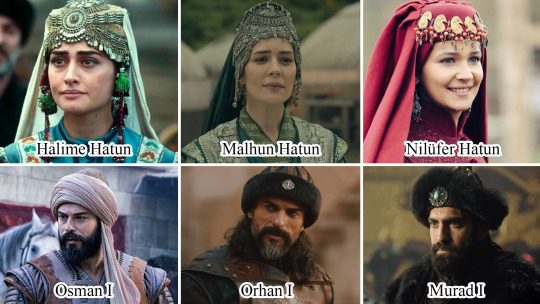
Gülçiçek Hatun, mother of Bayezid I. Contrary to legend, Gülçiçek was a slave, perhaps of Greek descent. It is not known when she became Murad I’s concubine, but her son was born in 1360. We don’t know much about Gülçiçek’s life, the exact number of her children. What is certain, however, is that she reached her son’s reign and during these years she had a mosque built in Bursa. With this, she became the first Valide Hatun to have a mosque built. The time of her death is not known either, so it is not clear that she was alive at the end of her son's reign when Bayezid I was captured by Timur Lenk in 1402. Gülçiçek was buried in Bursa in her own complex.
Devlet Hatun, mother of Mehmed I. Devlet was also a woman of slave origin. In her case, there is no doubt about that, as there is evidence available. She is listed in the records of one of her foundations as Daulat bint-i Abd’Allah, meaning she was the daughter of a non-Muslim and non-Turkish man. We don’t know much about her life, for there was a legal wife in Bayezid I’s life who was much better known, so Devlet didn’t really get into the spotlight. After the abduction and death of Bayezid I, the empire operated under interrgnum rule, so the sons of Bayezid divided the empire together. This ended in 1413 when Devlet's son Mehmed became monarch after defeating his brothers. However, Devlet was not able to enjoy the Valide Hatunship for long, as she died in January 1414 and was buried in Bursa, just after a year-long tenure.
Emine Hatun, Murad II's supposed mother. The identity of Murad's mother is still disputed to this day. In terms of her origins, Emine was a princess of Dulkadir, the child of an influential family. She officially married Mehmed Çelebi in 1403, when the Ottoman interregnum began. Their marriage was purely political, as Mehmed tried to gain - successfully - the support of the Dulkadir family, who eventually became key figures in his enthronement. In addition to Emine, it also arises that Murad's mother was the daughter of a family of noble descent called Şehzade Hatun. But it is also possible that an unnamed and insignificant slave was Murad's mother. We don't know when Emine or Şehzade Hatuns died.

Hüma Hatun, Mehmed II's mother. There are also many legends around Hüma, some say she was a Byzantine princess, others say she was a simple slave, but Venetian and Hungarian origins also arise. Most likely, however, Hüma was a simple slave, as her name suggests. She is mentioned in the records of one of her foundations as "Hatun bint-i Abdullah", which was one of the usual names for women of slave origin. We know very little about Hüma's life, which was not helped by the fact that her son Mehmed refused to ever talk about his mother. What is certain is that in 1343 she followed her son Mehmed to Amasya, where the sultan appointed Mehmed as governor. The next year Sultan Murad became depressed and resigned from the throne, so in 1344 Mehmed took over. At that time Hüma became Valide Hatun, but instead of the young sultan, the Grand Vizier ruled. So there was no real power in the hands of Hüma either. Then, in 1346, Sultan Murad returned, and Mehmed's brief reign came to an end. Hüma spent the next few years in Bursa, and her life from here on again was a set of question marks. Some say she died in 1449 before Mehmed could ascend the throne in 1451, others said that mother and son had arguments, which is why Hüma never followed her son to the conquested Constantinople and therefore never became Valide Hatun to her adult son.
Gülbahar Hatun, Bayezid II's mother. In the case of Gülbahar, too, a foundation document has survived, which clarifies that she was a woman of slave descent. Her origin was Greek or Albanian. In 1455/6 Bayezid was appointed by his father, Mehmed II as governor of Amasya, so Gülbahar and Bayezid traveled there and remained there until 1581 when Mehmed II died. During this time, Gülbahar was very active in Amasya. She held huge fortunes and also dealt a lot with local politics compared to her predecessors. Gülbahar was a rather strong-willed woman who certainly easily coped with the rule of the huge Old Palace after her son's accession to the throne in 1581. Her strong personality is well illustrated by one of her letters, in which she rebukes his adult son, Sultan Bayezid, for not visiting her often enough. In his letter, she writes, "My fortune, I miss you. Even if you don't miss me, I miss you ... Come and let me see you. My dear lord, if you are going on campaign soon, come once or twice at least so that I may see your fortune-favored face before you go. It's been forty days since I last saw you. My sultan, please forgive my boldness. Who else do I have beside you ... ?" Gülbahar's other letters also show that she often advised her son on political matters as well. She eventually died in 1492 after 11 years of rule and was buried in Istanbul. Gülbahar was the first Valide Hatun to rule in Istanbul and to have a significant influence on her son and politics as well.
Ayşe Gülbahar, mother of Selim I. Ayşe Gülbahar is mentioned in one of her foundation documents as "Hatun bint-i Abd-us-Samed", which was a typical mention for Christian-born Balkan and Anatolian converts. Based on this, it is probable that Ayşe Gülbahar was an Anatolian or Balkan slave who then became the concubine of Bayezid II. Ayşe Gülbahar, as I mentioned above, had high-arching eyebrows like angular hats over her dark, deep-set eyes, she shot daggers at those who prostrated in deference to her. Certainly the similar features of her son, Selim I was inherited from her. Ayşe Gülbahar gave birth to her only son Selim in 1470, with whom they lived in the harem of Bayezid until Selim became governor of Trabzon. In Trabzon, Ayşe Gülbahar had great influence, but as her son became more and more mature, she became more and more relegated to the background. Ayşe Gülbahar did not reach Selim's reign as she died in Trabzon presumably sometime before 1511. In 1514 her son, Selim had a complex built in Trabzon in memory and honor of his mother.

Valide Sultan
During his reign, Bayezid II created the title of Sultan (Sultana), which his daughters could use. Thanks to the rank of Sultan, the female members of his family rose well above the other Hatuns (women). However, Bayezid did not extend the title to his own mother, Gülbahar. Selim I's mother, Ayşe Gülbahar, died before Selim ascended the throne. Thus, in the end, it was Suleiman I who extended the title of Sultan to his mother. Thus, not only his aunts, sisters, and daughters could hold the title of Sultan, but also his mother, Ayşe Hafsa. With this, Ayşe Hafsa became the first Valide Sultan. However, this change in responsibilities did not mean anything. The Valide Sultan was still responsible for keeping the imperial harem in order after her son ascended the throne, supervising the sultan's family (concubines, children). As much as the remit remained the same, so much changed in the addressing. Previously, Valide Hatun was a respectful address for mothers, so they were already called that in the provinces. Valide Sultan, on the other hand, was clearly only a title reserved for the sultan's mother.
Murad III brought a huge change for the rank of Valide Sultan. Until then, Valide Sultan was only a respectful name for the sultan's mother, there was no official, legal title for it. By official, legal title, I mean, such as the Grand Vizier or the Chief eunuch. These positions had specific responsibilities and were not just addressing, but real titles, positions. It was Murad III who, on his accession to the throne in 1574, made the title of Valide Sultan a registered, official and legal title. This was a huge step forward for the Valide Sultan of all time. From then on, her role became official. She was not only the sultan’s mother but a person in her own right as Valide Sultan. Previously, the Valides signed their letters and foundation documents as the mother of the Sultan XY, but from then on they could sign them as the XY Valide Sultan.
The changes created by Murad III practically lasted until the end of the empire’s existence. Though the Valide Sultan over time lost the prominent influence she represented in the 16th and 17th centuries. In the 16th and 17th centuries, the power of Valides reached unprecedented levels. Due to unfit sultans, child sultans, and the evolution of the geopolitical situation, several of them were de facto or official regents. After the end o their regencies, their primary role was to keep the sultans’ harem in order, but they also paid special attention to charity and politics. In the 16th and 17th centuries, no Valide Sultan could be found without a political role.
List of Valide Sultans, supplemented by mothers who did not survive their son's reign:
Ayşe Hafsa Sultan, mother of Suleiman I. Ayşe Hafsa was the concubine of Selim I, who gave birth to at least three children. We don't know much about her early years. Hafsa was the first slave to hold the title of Sultan after her son, Suleiman, ascended the throne. The rule of Ayşe Hafsa was quite similar to her predecessor, Gülbahar. Hafsa led Suleiman’s harem in the Old Palace, creating a balance between her son’s concubines, paying attention to the well-being of her grandchildren, and doing plenty of charity. Hafsa was loved and respected by all, she was one of the most adored Valide Sultans. She was politically minimally active, had her own men, and when her son asked for her opinion, she tried to help him. However, Hafsa never wanted to overrule her son, so she didn’t even deal with politics more than necessary. She was Valide Sultan for 14 years, and after her death in 1534 she became the first slave-origin woman to receive an imperial burial. A longer biography is available at link.
Hürrem Sultan, Selim II's mother. Hürrem was a woman of Ruthenian origin who gave birth to six children to Sultan Suleiman I. Hürrem played a real form-breaking role, as she was associated with the abolition of several previous rules (one-concubine-one-son, marriage of sultans, residence of concubines) and associated with the creation of several new roles (Haseki Sultan title, harem leadership, sending princes alone to the province, etc.). However, Hürrem never saw her son Selim II to became a sultan, as he ascended the throne in 1566 and she died in 1558. A longer biography is available at link.
Nurbanu Sultan, Murad III's mother. Nurbanu was a slave of Venetian origin who then became the concubine of Selim II and gave him several children. We do not know much about her early years as she came into the public consciousness when in 1566 Selim ascended the throne. Nurbanu is a special woman in several aspcts: she was the first to hold the rank both of Haseki Sultan and Valide Sultan; and she also was a legal wife. To show his respect for his mother Murad III created a real official title out of the Valide Sultan title, making Nurbanu the first to wear it. Throughout her life, she did a lot of charity, building projects, and also had a huge influence on politics, her son asked for her opinion on everything. She was a Valide Sultan for 9 years from 1574 until her death in 1583. A longer biography is available at link.
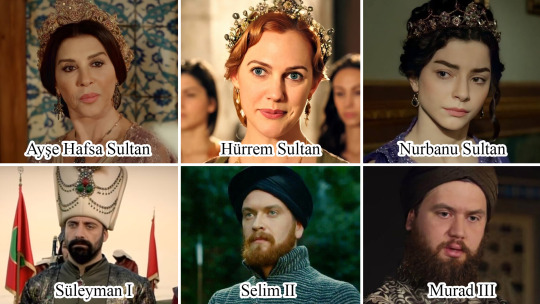
Safiye Sultan, Mehmed III's mother. She was a concubine of Albanian descent, raised and taught by Suleiman I's granddaughter, Hümaşah Sultan. She gifted the girl to the later Murad III, with whom she had several children. Safiye reached both hell and heaven as she had a privileged status as Haseki Sultan and then was exiled and then became a legal wife. She reached the peak of her power as Valide Sultan when she ruled instead of her son Mehmed, who was unfit to rule. She was not popular at all, there were several uprisings against her persona, during which several of her supporters were executed. Safiye was the first Valide Sultan (and probably even the first Valide) to survive her sultan-son. This created an unusual situation, and it was not clear to her grandson Ahmed I what to do with his grandmother. Eventually, due to her unpopularity, Safiye was sent to the Old Palace, which has become the palace for the family of the deceased sultans so far. The influential Safiye, who had previously ruled the empire, found it difficult to bear this and felt it as an exile. It was for this reason that, in revenge, she completely damaged the Sultan's harem in Topkapi Palace, making her own return permanently impossible. Seeing her grandson and the rule of two more sultans, she finally died around 1620. A longer biography is available at link.
Handan Sultan, mother of Ahmed I. Handan was a slave of Bosnian origin who was raised and educated by Selim II's daughter, Gevherhan Sultan. Handan could not prevail at a young age as her tyrant's mother-in-law, Safiye suppressed all of Mehmed III's concubines. Handan found herself finally in the spotlight in 1603, when Mehmed died and the son of Handan, ascended the throne. The young sultan, Ahmed, was only 13 years old, so regents were needed beside him. Sultan Ahmed had two regents, his mother Handan and his teacher. Handan was an unofficially appointed regent but practically ruled instead of her son for months, attended audiences, organized political cleansing (to get rid of Safiye Sultan's men). Handan's life ended quite early, and due to her death in 1605, she became one of the shortest reigning Valide Sultans, with only 2 years of reign. At the same time, we must not forget that she was the first female regent of the empire. A longer biography is available at link.
Halime Sultan, mother of Mustafa I. Unlike Handan, Halime, who was also Mehmed III's concubine, was intolerant of Safiye Sultan's bullying and she tried to pick up the fight with her mother-in-law. Her ambitions were also shared by her son, Mahmud, who repeatedly spoke openly against his grandmother and father, the Sultan. The battle between Safiye and Halime ended in the summer of 1603, when, under pressure from Safiye, the sultan executed Mahmud. The life of Halime was spared, but soon her other son, the toddler Mustafa was separated from her. Mustafa struggled with serious mental problems, which is why it was surprising when, after Ahmed I's death, he was finally chosen as heir. Ahmed was the first sultan not to execute his brothers when he ascended the throne, and this led to a change in the order of inheritance. From then on, it was not the sultan's son who followed the sultan on the throne, but the eldest living prince. Due to Mustafa’s tragic mental state, Halime ruled instead of him as the first official regent. In times of political instability, Mustafa was dethroned but was soon proclaimed sultan again. This made Halime the first Valide Sultan to be the Valide Sultan twice with the same son. After Mustafa's second dethronement, mother and son continued to live in isolation for many years. A longer biography is available at link.
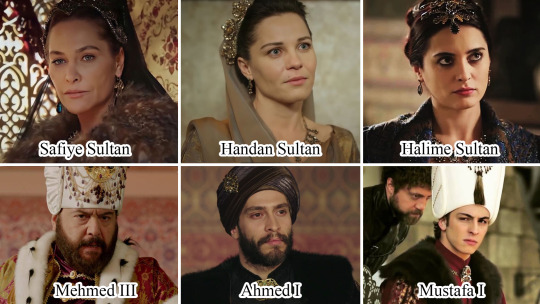
Mahfiruz Hatun, mother of Osman II. Mahfiruz was Ahmed I's concubine, who, although was the eldest son's mother, was not Ahmed's favorite concubine. We know quite a bit about Mahfiruz's personality and actions due to her early death. Not living long enough to see her son's accession to the throne in 1618, she never became Valide Sultan. Her name also suggests this, as she was buried as Mahfiruz Hatun, not as Mahfiruz Sultan. A longer biography is available at link.
Kösem Sultan, the mother of Sultans Murad IV and Ibrahim I. Kösem, of Greek descent, found herself in a rather volatile political and geopolitical situation when her partner Ahmed I passed away. During the chaos of inheritance, she lost her eldest son, whom Osman II executed. Osman soon suffered a similar fate after being brutally murdered by rebellious Janissaries. The chaotic period ended in 1623 when Kösem's son Murad has proclaimed a sultan at just 11 years old. Kösem ruled as regent instead of him for many years, then when her son became old enough to rule, she retired. Kösem did a lot of charity during her Valide Sultanship and sought to be a political adviser to his son. Murad - not having a living son - was succeeded by his younger brother Ibrahim, who was also the son of Kösem. Ibrahim was mentally ill, like his uncle, so instead, Kösem ruled as an unofficial regent. Due to her two sons, Kösem was practically Valide Sultan from 1623 to 1648, so for 25 years. Eventually, Ibrahim was dethroned and replaced by his six-year-old son, Mehmed IV. The pashas asked the experienced Kösem Sultan to teach the young sultan and his mother Turhan Hatice to rule. And until then they asked Kösem to rule as a regent again. However, she acted differently and began to rule violently. This ended with her execution in 1651. She was the first and only Valide Sultan to be executed. A longer biography is available at link.
Turhan Hatice Sultan, Mehmed IV's mother. Turhan, of Russian descent, had a rather difficult youth as the concubine of the mentally ill Ibrahim I. The difficult period finally ended in 1651, when Turhan became the official regent to her son. She performed this task for only a few years and then handed over power to the Grand-Vizier. Throughout Turhan's life, she was politically very active, her son regularly sought his mother's opinion, and many times Turhan ruled by herself as her son did not like to rule. During her life, Turhan defended with all her might his foster sons, whom Mehmed wanted to execute at one point in his reign. Turhan Hatice was a truly respected and beloved Valide Sultan, who did a lot of charity and also carried out monumental constructions during her long reign. She was the longest reigning Valide, having held office for 32 years. At her death in 1683, the whole empire mourned and the people believed that the empire had lost its last strong and stable pillar. Unfortunately, they were right, Turhan's son was soon dethroned because he was unable to rule properly without his mother's advices. A longer biography of Turhan Hatice is available at: link.

Saliha Dilşub Sultan, Suleiman II's mother. Saliha Dilaşub, like Turhan and Ibrahim I’s other concubines, experienced rather confusing times in her youth. It is likely that Kösem Sultan wanted to use her and her son during a coup against Mehmed IV and Turhan Hatice in 1651. The coup was unsuccessful, Kösem Sultan was executed, however, Mehmed and his mother forgave Saliha and her son Suleiman. Moreover, Turhan protected Saliha's son throughout her life. Saliha Dilaşub lived in the Old Palace for almost forty years, separated from her son during the whole reign of Mehmed IV. Finally, after the dethronement of Mehmed in 1687, Saliha was able to leave the Old Palace to became a Valide Sultan to her son. Unfortunately, however, she did not enjoy this for long, as she died only after 2.5 years of rule. Her reign thus remained relatively gray, and although her philanthropy is known, she did not have time to activate herself politically. A longer biography is available at link.
Hatice Muazzez Sultan, Ahmed II's mother. Along with Saliha Dilaşub and Turhan, Muazzez was also the concubine of Ibrahim I and had a rather hard youth. We know very little about Muazzez's life, presumably, she had a daughter besides Ahmed. She spent 40 years in the Old Palace. During Mehmed’s reign, she barely met her son Ahmed. In September of 1687, a huge fire destroyed the Old Palace, and Muazzez, fearing the fire had a heart attack and died a few days later. Barely two months after her death, Saliha Dilaşub, who was "imprisoned" along with her, was able to leave the Old Palace, as her son Suleiman II became the sultan. Muazzez's son Ahmed II succeeded Suleiman in 1691. A longer biography is available at link.
Emetullah Rabia Gülnüş Sultan, mother of Mustafa II and Ahmed III. She was a woman of Greek descent who from a slave became the last influential woman of the Sultanate of Women. She was both a Haseki and Valide Sultan in her life, so she held the two most important titles of the era. In her youth, she had a huge influence as a favorite and was very active politically. When her partner, Mehmed IV was dethroned, Emetullah was forced into the Old Palace, which she could only leave in 1694, when she became a Valide Sultan to her son Mustafa II. She raised her former influence to even higher levels, having an amazing influence on political life and her son. Unfortunately, this aroused the disapproval of the pashas. Finally, her son was dethroned in 1703, and also Mustafa soon died of natural causes. Emetullah mourned her son and then, learning from her mistakes, throughout the reign of Ahmed III's, she remained in the background and worked closely with the pashas. Lots of charities, construction can be linked to her. Due to her two sons' reigns, she was a Valide Sultan for a total of 20 years. A longer biography is available at link.
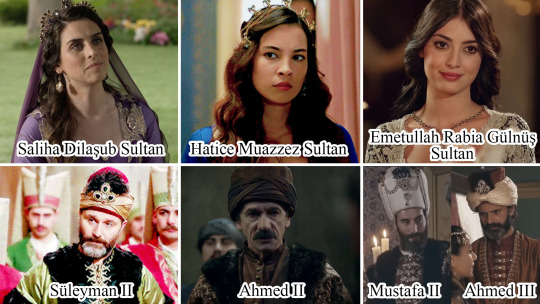
Saliha Sultan, mother of Mahmud I. She was a woman of Serbian descent. As the concubine of Sultan Mustafa II, she had no prominent influence but had the opportunity to learn a lot from her mother-in-law, Emetullah Rabia Gülnüş. She gave birth to her son in 1696, and soon after, in 1703, Mustafa was dethroned and so she moved to the Old Palace. There, however, she did not accept her exile, she constantly was building relationships. In 1730 she was finally could leave Old Palace as her son, Mahmud I, ascended the throne. She was a Valide Sultan for 9 years and similarly to her predecessor, Emetullah Rabia Gülnüş, she gained amazing power. Everyone was trying to get into her graces to ensure their own advancement. They tried to win over the influential Valide with gifts. During her tenure, she embarked on several smaller construction projects, so there are several fountains she built in Istanbul. One such is the Azapkapı Saliha Sultan Fountain, the most beautiful water architectural monument in Istanbul.
Şehsuvar Sultan, mother of Osman III. She was the concubine of Mustafa II, but she could enjoy the spotlight for only a short period. Her child was born in 1699, and in 1703 she found herself in the Old Palace after the dethronement of Mustafa II. Like Saliha, Şehsuvar could no longer raise her son as the princes were taken to Topkapi Palace. Finally, in 1754, she was able to find herself on her son's side again when Osman became the new sultan of the empire. Osman, who had barely been able to meet his mother for decades, refused to immediately hold the coronation ceremony, as he only wanted to spend three days with his mother. Şehsuvar's reign was quite short, as she was a Valide Sultan for only 1.5 years. She died in 1756. No political, charitable or construction projects took place during this time. In some political cases, however, her role is possible, so she cannot be considered completely politically inactive.
Mihrişah Kadın, was Mustafa III's mother. She was the concubine of Ahmed III, and gave birth to three sons with quite large age differences (1710, 1717, 1728). After the dethronement of Ahmed III in 1730, Mihrişah was moved to the Old Palace, where she died two years later, 25 years before her son's accession. During her lifetime, she had some minor construction projects though she could never have been Valide Sultan.
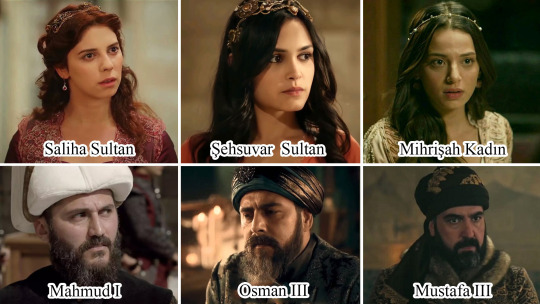
Rabia Şermi Kadın, mother of Abdul Hamid I. Şermi was Ahmed III's concubine, with whom she had only one child, in 1725, Abdul Hamid. Şermi died in 1732, more than 40 years before her son accession. During her short life she could not leave a deep mark on history, she only had a single fountain built. Her son later named one of his children, Rabia, in her honor, but the little girl died shortly after her birth.
Mihrişah Sultan, Selim III's mother. Mihrişah was the concubine of Mustafa III. It is an interesting coincidence that Mustafa's mother was also called Mihrişah. The beautiful Georgian slave became the concubine of Mustafa in 1757. She had three children, but only Selim reached adulthood, as her two daughters died as infants. We don't know much about her youth, but she certainly had great wealth even then, because according to surviving documents, the sultan himself owed to her. After the sudden death of her partner in 1774, she was exiled to the Old Palace, from where she could only return 15 years later when her son Selim ascended the throne. Mihrişah was a Valide Sultan for 16 years alongside Selim. During these years, she strongly supported her son’s innovations. The renovation of the harem of Topkapi Palace can be linked to her name, but she also had several construction projects. Mihrişah and her son were very close to each other, they discussed everything and according to some Selim visited his mother every morning. Regardless, Mihrişah did not use her influence, did not interfere in politics, but rather spent her time in religion and charity. She died in 1805.
Sineperver Sultan, Mustafa IV's mother. In 1774 she became Abdul Hamid's concubine and in 1779 gave birth to her son. So far, Sineperver has buried a son. Because of the tragic memory, she asked for prayers for Mustafa's health after his birth and she paid the debt of prisoner so they could be released. Her prayers were heard, Mustafa reached adulthood, so did Sineperver’s daughter, Esma Sultan. Her other daughter, Fatma, on the other hand, died as her first child, Ahmed. In 1789 Abdul Hamid died and Sineperver moved to the Old Palace. She was able to leave it in 1807, when her son, Mustafa IV became sultan. Unfortunately, Mustafa's reign was rather short, he sat on the throne for barely 1 year, then he was dethroned and soon executed. Sineperver dedicated her remaining years to her only living child, Esma Sultan. She died in 1828.
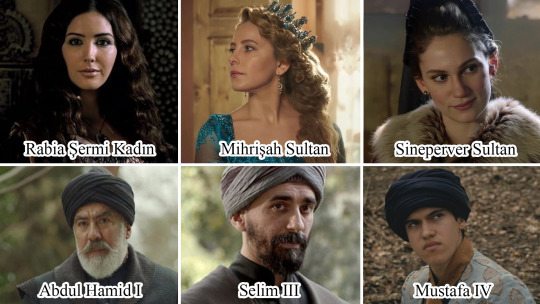
Nakşidil Sultan, Mahmud II's mother. For a long time there was a theory that she was a distant relative of Josephine, Napoleon's wife. But it has now been proven that she was a slave of Georgian descent. She gave birth to her son Mahmud in 1785 as the concubine of Abdul Hamid. Unfortunatelly Abdul Hamid died in 1789 and Nakşidil moved to the Old Palace. In 1808 her stepson, Mustafa IV ascended the throne. He then executed his predecessor Selim III and also sent assassins against Nakşidil's son Mahmud. Nakşidil hid her son, so he survived and soon became a sultan in a coup. In return for Mustafa IV's attempted murder, Mahmud executed his half-brother immediately after his accession to the throne. Nakşidil moved back to Topkapi Palace during a huge ceremony. She was the last Valide to travel from the Old Palace to Topkapi in such way. One reason for this was that the dynasty began to favor other imperial palaces over Topkapi. (Actually it was Nakşidil whose idea was to change palace.) In the early years of Mahmud’s reign, he regularly consulted with his mother. The Valide Sultan did a lot of charity and also had smaller to larger construction projects. Nakşidil was a Valide Sultan for 9 years since she died of tuberculosis in 1817. Her son Mahmud, her daughter-in-law, Bezmialem and her grandson Abdulmejid also died of this disease.
Bezmialem Sultan, mother of Abdulmejid I. The woman of Georgian descent became Mahmud II's concubine in 1822. Bezmialem was raised by Mahmaud II’s half-sister, Sineperver’s daughter, Esma Sultan. Maybe that’s where her sophistication and intelligence comes from. In 1823, she gave birth to her only child, Abdulmejid. In 1839 Mahmud died and Abdulmejid became sultan. After her son's accession, Bezmialem ruled as Valide Sultan for 14 years. Abdulmejid was only 16 years old when he ascended the throne, so his mother helped him a lot in the early years. There was a very close link between mother and son, often corresponding with each other, letters never written by secretaries but by themselves, with their own hands. When the sultan left the capital, he always made his mother the head of the capital for the duration of his absence. Bezmialem was a dedicated philanthropist that the people loved immensely. She also made her construction projects known as well as her political influence. Bezmialem died of tuberculosis in 1853. Her son was shocked after hearing the news. After the death of his mother, the sultan spent an astonishing amount of money on the funeral.
Pertevniyal Sultan, mother of Abdulaziz. She gave birth to her only child, Abdulaziz in 1830 after becoming a concubine of Mahmud II. She was either Kurdish or Romanian descent. After Mahmud's death in 1839, Abdulaziz's brother Abdulmejid ascended the throne. Then in 1861 Abdulmejid also died and Abdulaziz followed. Pertevniyal was Valide Sultan for 15 years, during which time she gained amazing influence and wealth. She had unlimited power on her son, which she regularly used to influence the ruler. During her reign she repeatedly hosted influential guests in the harem. One such occasion almost ended in a diplomatic scandal as she slapped the French guest. However, in addition to her strong and sudden nature, she did a lot of charity and built. Pertevniyal's son was dethroned in 1876 and locked up in Topkapi Palace. A similar fate awaited Pertevniyal. Abdulaziz couldn't stand the confinement and cut his veins with scissors. The possibility of murder also arose, but all doctors who examined Abdulaziz's body ruled out this. Pertevniyal was shocked. The ascension of Abdul Hamid brought some relief for her as he loved Pertevniyal very much and he took care of the woman. For the rest of Pertevniyal's life, she retired and raised, taught children entrusted to her care. She died in 1884.

Şevkefza Sultan, mother of Murad V. She, a Georgian woman became Abdulmejid's concubine in 1839. In 1840 she gave birth to her son, Murad, who was soon followed by a little girl who died early. Şevkefza is a relatively gray character in history, having been Valide Sultan for only 3 months as her son was very quickly dethroned because of his mental condition. After Murad V's dethronement in 1876, Şevkefza wanted to put her son back on the throne in a coup, but Murad showed no interest. Şevkefsa finally died in 1889 from some kind of neck cancer.
Tirimüjgan Kadın, mother of Abdul Hamid II. She was a beautiful woman of Armenian descent who became a consort of Sultan Abdulmejid in 1839. Her son Abdul Hamid was born in 1842. Beside him, she had two other children, but they died early. Tirimüjgan was a woman with poor health, though she nevertheless tried to give everything to her son. She was finally died in 1852. She entrusted her son to Nergisnihal Hanım, one of her servants, who remained with Abdul Hamid for the rest of his life. In addition, Tirimüjgan was close to the Sultan's other concubine, Perestu, so that the Sultan eventually left Abdul Hamid to Perestu's care. Perestu had already raised another orphaned child, Cemile Sultan, as she had no children of her own. Cemile and Abdul Hamid eventually grew up in the same household. When Abdul Hamid became Sultan in 1876, he nominally gave Perestu the rank of Valide Sultan, making her the last great Valide of the empire. Abdul Hamid nicely asked Perestu not to interfere in politics, which she agreed happyly. Perestu's life was charity as she was a kind nature who was not a fan of politics anyway. She died in 1904 after 28 years of rule.
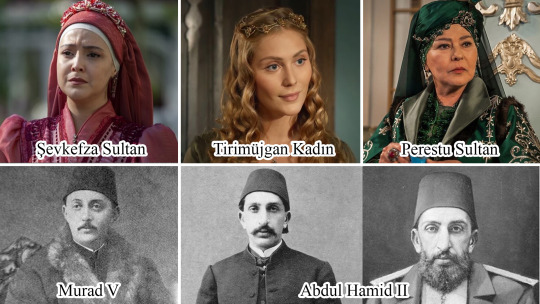
Gülcemal Kadın, mother of Mehmed V. She was a woman of Bosnian descent who had three children from Abdulmejid. She died of tuberculosis in 1851, and her children were raised by Servetseza Kadın. Mehmed ascended the throne in 1909, but Servetseza did not survive until that day because in 1878 she died.
Gülüstü Hanım, Mehmed VI's mother. Gülüstü came from an Abkhazian noble family and became the concubine of Sultan Abdulmejid in 1854, and in 1861 she gave birth to her second child, a son, Mehmed. Not much time was given to her and her children, having died out of cholera in 1865. Her little daughter was entrusted to the care of Verdicenan Kadın, and Mehmed was raised by Şayeste Hanım. Şayeste was also a descendant of an Abkhaz noble family, but she had a hard time coming out with Mehmed. Mehmed left his foster mother's mansion at the age of 16 with three if his faithful servants. Although the relationship between the two of them was not perfect, Mehmed later took care of Şayeste because he was grateful to her for raising him. Mehmed became sultan in 1918, while Şayeste died in 1912, so she never became Valide. However, judging by the relationship between the two of them, probably she would not have been a Valide even if she was still alive when Mehmed ascended the throne.

List of the Valides based on their tenure:
Turhan Hatice Sultan 34 years 11 months 2 days
Rahime Perestu Sultan 28 years 3 months 11 days
Kösem Sultan 24 years 10 months 29 days
Nilüfer Hatun 21 years
Emetullah Rabia Gülnüş 20 years 9 months
Mihrişah Sultan 15 years 6 months 9 days
Pertevniyal Sultan 14 years 11 months 5 days
Bezmialem Sultan 13 years 10 months
Ayşe Hafsa Sultan 13 years 5 months 19 days
Gülbahar Hatun 11 years
Nakşidil Sultan 9 years 25 days
Saliha Sultan 9 years 1 day
Nurbanu Sultan 8 years 11 months 23 days
Safiye Sultan 8 years 11 months 7 days
Gülçiçek Hatun 3 years 1 month 4 days
Dilaşub 2 years 1 month 27 days
Hüma 2 years 1 month
Handan Sultan 1 year 10 months 18 days
Halime Sultan 1 year 6 months 26 days
Şehsuvar 1 year 4 months
Sineperver Sultan 1 year 1 month 29 days
Devlet Hatun 6 months 18 days
Şevkefza Sultan 3 months 1 say
* * * * * * * * * * * * * * * * * *
A Valide rang a mindenkori szultán édesanyjának rangja volt. Azonban ez a logikusnak tűnő titulus is rengeteg változáson ment át a szultánátus évszázadai során. Ezen posztomban szeretném bemutatni ezt a változást és megismertetni az szultánok édesanyját I. Oszmántól az utolsó szultán VI. Mehmed édesanyjáig.
Valide Hatun
A korai évszázadokban a Valide Sultan titulus még nem létezett, helyette a Valide Hatun volt használatban. A Valide gyakorlatilag az édesanya megszólítása, a Hatun pedig az asszonyok tiszteletteljes megszólítása volt, gyakorlatilag olyasmi, mint az "Asszonyom". Így a Valide Hatunt már akkor Valide Hatunnak hívták gyakorta, mikor fia még nem volt szultán, csupán provincia irányítója. A Valide Hatun feladata már jóval azelőtt elkezdődött, hogy fia trónra lépett volna. Ekkoriban még csak egyszerű ágyasok voltak ezek a nők, akik a szultán háremében éltek. Ez idő alatt gyermekeik ellátása és nevelése volt az elsődleges felataduk, majd később egyetlen fiukat (nem lehetett több fiuk az egy ágyas - egy fiú törvény miatt) elkísérték annak kijelölt provinciájába. A provinciában a Valide Hatun feladata volt, hogy a fiatal herceg udvartartását kézben tartsa és elkezdje fia háremének kialakítását, az ágyasokat és unokákat fegyelmezze. Amennyiben voltak lánygyermekei a Valide Hatunnak, akkor ők is anyjukkal és öccsükkel tartottak a kijelölt provinciába.
A Valide Hatun egyébként pozíciójának csúcsán akkor volt, míg fia ifjú volt, így annak provinciájában viszonylagos szabadsággal foglalkozhatott mindenféle ügyekkel. Erre remek példa egy I. Szelim édesanyjáról, Ayşe Gülbahar Hatunról írt beszámoló. Ayşe Gülbahar hetente tartott audienciát Trabzonban, Szelim provinciális posztján, ahol mindenki hatalmas tisztelettel hallgatta szavait. Ahogy aztán Szelim egyre idősebb lett és egyre jobban beletanult az uralkodásba, anyja mind inkább háttérbe szorult. Ugyanígy volt ez természetesen az összes többi Valide Hatunnal is.
Mikor fiuk trónra lépett a Valide Hatun feladata lett, hogy a háremet irányítsa, rendben tartsa. Politikai befolyásuk nem volt, néhány kivételes esetet leszámítva. Természetesen feladataik mellett a Valide Hatunok rengeteget jótékonykodtak és amennyiben volt rá idejük, építkezési projekteket is létrehoztak. Gyakorlatilag a jótékonykodás és építkezés onnantól kezdve jogukban állt, hogy fiukat elkísérték provinciába. Emiatt van az, hogy a legtöbb majdani Valide Hatunnak fia egykori provinciájában van építkezése.
Természetesen ahogy az idő haladt a Valide Hatun feladatai is nehezedtek. Korábban az Oszmán Birodalom is kisebb volt, a főváros és a szultáni palota is szerényebb volt, így a háremet is relatíve könnyű volt rendben tartani. Konstantinápoly elfoglalása után azonban a hatalmas Régi Palota lett a szultán háremének otthona, ami egy valódi kis város volt a városban (bővebben itt olvashattok róla). Párhuzamosan a Régi Palotába költözéssel a Valide Hatun politikai befolyása is egyre növekedett. És szépen lassan a Valide hatalmának csúcsa is áthelyeződött. Többé már nem a provinciákban élhették meg a legbefolyásosabb időszakukat, hanem a fővárosban, fiuk uralma alatt.
A de facto and klasszikus Valide Hatunok listája, kiegészítve azokkal az anyákkal, akik nem érték meg fiuk uralmát:
Halime Hatun, I. Oszmán feltételezett édesanyja. Sok a róla keringő legenda, így néhányan azt állítják, hogy Szeldzsuk hercegnő volt, azonban nincs erre utaló bizonyíték. Valószínűbb, hogy egyszerű közember volt, vagy egy befolyásosabb család gyermeke. Az ekkori bégek, uralkodók ugyanis nem volt jellemző, hogy rabszolgákkal házasodtak volna vagy a klasszikus értelemben vett háremet tartottak volna. Nem tudunk semmit Halime életéről, arról, hogy hány gyermeke volt, mikor született, mikor halt meg... Még az sem bizonyos, hogy ő volt I. Oszmán édesanyja.
Malhun Hatun, I. Orhan édesanyja. I. Orhan volt az első klasszikus értelemben vett szultán, ám még ő is átmenetet képezett a valódi szultánátus és a korábbi törzsi rendszer között. Malhun Hatun egyesek szerint befolyásos törzsből származott, mások szerint egy sejk lánya volt. Akárhogy is, bizonyosan I. Oszmán hites felesége volt és ő adott életet a későbbi I. Orhannak. Őt tartják az Oszmán Birodalom és az Oszmán család anyjának. Születési ideje, gyermekeinek pontos száma nem ismert, ám azt tudjuk, hogy 1323-ban halt meg. Erre utal legalábbis, hogy fia 1324-ben építtetett tiszteletére komplexumot. Mivel ez a dátum egybe esik Orhan uralkodásának kezdetével, az sem zárható ki, hogy Malhun jóval előbb elhunyt. Lehetséges, hogy egyszerűen fiának - lévén nem volt még uralkodó - nem volt lehetősége adózni anyja emléke előtt. Így végül trónra lépése után tudott leghamarabb belefogni egy komplexum építésbe, hogy végre leróhassa tiszteletét. Akárhogy is, valószínűsíthető, hogy Malhun, fia uralmát nem, vagy alig érte meg. Ebben az értelemben pedig ő sem viselhette a Valide Hatun rangot.
Nilüfer Hatun, I. Murad édesanyja. Nilüfer volt az első, aki szinte minden kétséget kizáróan rabszolgasorból emelkedett a szultán anyjának rangjára. Mindemellett azt is tudjuk róla, hogy 1324 után lett Orhan ágyasa, ugyanis nem szerepel egy 1324-es jegyzékben, mely említi Orhan többi fő ágyasát (akik gyermeket szültek a szultánnak) vagy feleségét. Nilüfer gyermeke, Murad 1326-ban született, ám a nő első feltételezett említésére csupán 1331-ben került sor, mikoris egy bizonyos Ibn Battuta nevű utazót üdvözölt Orhan nevében Nikeában. Ez alapján és Murad születési éve alapján úgy kalkulálhatunk, hogy Nilüfer 1300 körül születhetett, de inkább utána. 1383-ban hunyt el, bőven megérve fia szultánná avanzsálását. Ezzel pedig ő lett az első Valide Hatun a birodalom történetében. 21 évig uralkodott, azonban nem tudunk sokat cselekedeteiről.

Gülçiçek Hatun, I. Bayezid édesanyja. A legendákkal ellentétben Gülçiçek rabszolga volt, talán görög származású. Nem tudni mikor vált I. Murad ágyasává, de fia a későbbi I. Bayezid 1360-ban született. Nem sokat tudunk Gülçiçek életéről, gyermekeinek pontos számáról. Az azonban bizonyos, hogy megérte fia uralkodását és ezen évek során építtetett egy mecsetet Bursa városában. Ezzel pedig ő lett az első Valide Hatun, aki mecsetet építtetett. Halálának ideje sem ismert, így az sem világos, hogy megérte e fia uralmának végét. I. Bayezidet ugyanis 1402-ben elkapta Timur Lenk és az ő fogságában hunyt el hamarosan. Gülçiçeket saját komplexumában helyezték örök nyugalomra Bursában.
Devlet Hatun, I. Mehmed édesanyja. Devlet szintén rabszolga származású asszony volt. Esetében ehhez kétség sem fér, hiszen bizonyítékok állnak rendelkezésre. Egy alapítványának irataiban úgy szerepel, mint Daulat bint-i Abd'Allah, ami annyit jelent, hogy egy nem muszlim és nem türk férfi lánya volt. Nem sokat tudunk életéről, ugyanis I. Bayezid életében jelen volt egy hites feleség, aki jóval ismertebb volt, így Devlet nem jutott igazán a reflektorfénybe. I. Bayezid elrablása majd halála után a birodalom interrgnum kormányzásban működött, tehát Bayezid fiai megosztva a birodalmat együtt uralkodtak. Ennek 1413-ban lett vége, mikor Devlet fia, Mehmed testvéreit legyőzbe egyeduralkodó lett. Devlet nem sokáig élvezhette azonban a Valide Hatun rangot, ugyanis 1414 januárjában halt meg és Bursában temették el, mindössze 1 év Valideség után.
Emine Hatun, II. Murad feltételezett édesanyja. II. Murad anyjának kiléte a mai napig vitatott. Származását tekintve Emine egy Dulkadir hercegnő volt, befolyásos család gyermeke. 1403-ban ment hivatalosan is feleségül Mehmed Çelebihez, mikor az Oszmán interregnum elkezdődött. Házasságuk tisztán politikai volt, ugyanis Mehmed így próbálta megszerezni - sikeresen - a Dulkadir család támogatását, akik végül kulcsfigurái lettek szultánná válásában. Emine mellett felmerül az is, hogy II. Murad anyja egy Şehzade nevű szintén nemesi származású család lánya volt. De az sem kizárt, hogy egy névtelen és jelentéktelen rabszolga volt Murad anyja. Nem tudjuk, hogy Emine mikor hunyt el.

Hüma Hatun, II. Mehmed édesanyja. Hüma körül is sok a legenda, egyesek szerint bizánci hercegnő volt, mások szerint egyszerű rabszolga, de a velencei és magyar származás is felmerül. A legvalószínűbb azonban, hogy Hüma egyszerű rabszolga volt, erre utal ugyanis neve és az, hogy egyik alapítványának irataiban "Hatun binti Abdullah" néven szerepel, ami a rabszolga eredetű ágyasok egyik megszokott megnevezése volt. Hüma életéről nagyon keveset tudunk, melyen az a tény sem segített, hogy fia II. Mehmed elutasította, hogy valaha is anyjáról beszéljen. Annyi bizonyos, hogy 1343-ban követte fiát, Mehmedet Amasyába, ahová a szultán nevezte ki Mehmedet mint helytartót. A következő évben II. Murad szultán depressziós lett és lemondott a trónról, így 1344-ben Mehmed vette át a feladatait. Ekkor Hüma Valide Hatun lett ugyan, de a fiatal szultán helyett elsősorban a nagyvezír uralkodott. Így pedig nem volt valódi hatalom Hüma kezében. 1346-ban aztán Murad szultán visszatért, és Mehmed rövid uralmának vége szakadt. Hüma a következő éveket Bursában töltötte, élete innentől pedig újra kérdőjelek halmaza. Egyesek szerint 1449-ben meghalt mielőtt Mehmed trónra léphetett volna 1451-ben, mások szerint anya és fia összekülönböztek, emiatt nem követte Hüma sosem fiát az időközben elfoglalt Konstantinápolyba és emiatt nem lett sohasem Valide Hatun felnőtt fia mellett.
Gülbahar Hatun, II. Bayezid édesanyja. Gülbahar esetében is fenn maradt egy alapítványi okirat, ami egyértelműsíti, hogy rabszolga származású nő volt. Esetében felmerül a görög vagy albán származás is. 1455/6-ban Bayezidet édesapja kinevezte Amasya kormányzójává, így Gülbahar és Bayezid oda utaztak és ott is maradtak 1581-ig, II. Mehmed haláláig. Ezidő alatt Gülbahar igen sokat tevékenykedett Amasyában. Hatalmas vagyonokat tartott kezében és elődeihez képest sokat foglalkozott a helyi politikával is. Gülbahar meglehetősen erőskezű nő volt, aki minden bizonnyal könnyedén megbírkózott a hatalmas Régi Palota irányításával fia 1581-es trónralépése után. Erős személyiségét jól mutatja egyik levele, melyben fiát - a már szultán Bayezidet - korholja, amiért az nem látogatja meg elég gyakran. Levelében így ír: "Mindenem, hiányzol. Ha én nem is hiányzom neked, te nagyon hiányzol nekem... Gyere, látogass meg, hadd lássalak. Drága uram, hamarosan hadjáratra mész, kérlek gyere előtte egyszer-kétszer, hogy lássam drága arcodat mielőtt elhagyod a várost. Már negyven napja nem láttalak. Drága szultánom, bocsásd meg nyersségem, de kim van nekem rajtad kívül...?" Gülbahar más leveleiből kitűnik az is, hogy gyakran adott tanácsot fiának politikai ügyekben is. Végül 1492-ben halt meg 11 évnyi uralkodás után és Isztambulban temették el. Gülbahar volt az első Valide Hatun, aki Isztambulban uralkodhatott és akinek jelentős befolyása volt fiára és a politikára is.
Ayşe Gülbahar, I. Szelim édesanyja. Ayşe Gülbahar egyik alapítványi okiratában "Hatun binti Abd-us-Samed" néven szerepel, ami tipikus említés volt a keresztény származású balkáni és anatóliai áttértek számára. Ez alapján valószínűsíthető, hogy Ayşe Gülbahar anatóliai vagy balkáni rabszolga volt, aki aztán II. Bayezid ágyasa lett. Ayşe Gülbaharról, ahogy fentebb is említettem feljegyezték, hogy hegyesen ívelt fekete szemöldöke volt, mélyen ülő fekete szemekkel, amelyeknek egyetlen pillantásával ölni tudott, ha valaki felbosszantotta. Minden bizonnyal tőle örökölte ezen tulajdonságát I. Szelim. Ayşe Gülbahar 1470-ben adott életet fiának, Szelimnek, akivel Bayezid háremében éltek egészen addig, míg Szelim nem lett Trabzon kormányzója. Trabzonban Ayşe Gülbahar nagy befolyással bírt, ám ahogy fia egyre jobban beletanult az uralkodásba, egyre inkább háttérbe szorult. Ayşe Gülbahar nem érte meg Szelim uralkodását, még Trabzonban meghalt feltehetőleg 1511 előtt valamikor. 1514-ben fia, Szelim Trabzonban építtetett egy komplexumot anyja emlékére és tiszteletére.

Valide Sultan
II. Bayezid uralkodása során - nem teljesen tisztázott, hogy mikor - létrehozta a Sultan (szultána) titulust, melyet lányai használhattak. A szultána rangnak köszönhetően családjának nő tagjai is jóval a többi Hatun (asszony) fölé emelkedtek. A titulust azonban Bayezid nem terjesztette ki saját édesanyjára, Gülbaharra. I. Szelim édesanyja, Ayşe Gülbahar pedig azelőtt elhunyt, mielőtt Szelim trónra lépett volna. Így végül I. Szulejmán volt az, aki kiterjesztette a szultána titulust édesanyjára is. Így nem csak nővérei, húgai és lányai viselhették a szultána rangot, de édesanyja, Ayşe Hafsa is. Ezzel Ayşe Hafsa lett az első Valide Sultan. A feladatkörökben ez a változás nem jelentett azonban semmit. A Valide Sultan feladata volt fia trónra lépése után a birodalmi hárem rendben tartása, a szultán családjára (ágyasai, gyermekei) való felügyelés. Amennyire változatlan maradt a feladatkör, annyira változott meg a megszólítás. Korábban a Valide Hatun az anyák tiszteletteljes megszólítása volt, így már a provinciákban is így szólították őket. A Valide Sultan viszont egyértelműen csak a szultán anyjának fenntartott megszólítás volt.
Hatalmas változást hozott III. Murad uralma a Valide Sultan rang számára. Addig ugyanis a Valide Sultan csupán egy tiszteletteljes megnevezése volt a szultán anyjának, nem volt hivatalos, bejegyzett titulus. Hivatalos, bejegyzett titulus alapján azt értem, mint amilyen például a Nagyvezír vagy a Fő eunuch volt. Ezek a tisztségek meghatározott feladatkörrel bírtak és nem csak megszólítások voltak, hanem valódi titulusok, tisztségek. III. Murad volt az, aki 1574-es trónralépésekor a Valide Sultan titulust egy bejegyzett, hivatalos ranggá tette. Ez hatalmas előrelépés volt a mindenkori Valide Sultan számára. Innentől szerepe hivatalossá vált, nem csupán a szultán anyja volt, hanem saját jogán Valide Sultan. Korábban a Validék leveleiket, alapítványi irataikat úgy jegyezték, mint a XY szultán anyja, innentől kezdve azonban XY Valide Sultanként írhatták alá.
A III. Murad által létrehozott változások gyakorlatilag a birodalom fennállásának végéig megmaradtak. Ugyanakkor a Valide Sultan idővel elveszítette azt a kiemelt befolyást, amit a 16. és 17. században képviselt. A 16. és 17. században ugyanis a Validék hatalma sosem látott szinteket ért el. Az alkalmatlan szultánok, a gyermek szultánok és a geopolitikai helyzet alakulása miatt többük volt de facto vagy klasszikus értelemben vett régens. Régensségük lejárta után, alapvető szerepük továbbra is fiuk háremének rendben tartása volt, ám emellett kiemelt figyelmet szenteltek a jótékonykodás és politika felé. A 16. és 17. században nem találni olyan Valide Sultant, akinek ne lett volna politikai szerepe.
A Valide Sultan rang viselőinek listája, kiegészítve azokkal az anyákkal, akik nem érték meg fiuk uralmát:
Ayşe Hafsa Sultan, I. Szulejmán édesanyja. Ayşe Hafsa I. Szelim ágyasa volt, aki legalább három gyermeknek adott életet. Korai éveiről nem tudunk sokat. Hafsa volt az első rabszolga, aki a szultána rangot viselhette, mikor fia, Szulejmán trónralépése után ezt engedélyezte neki. Ayşe Hafsa uralma meglehetősen hasonlított nagynevű elődjéhez, Gülbaharéhoz. Hafsa irányította Szulejmán háremét a Régi Palotában, egyensúlyt teremtett fia ágyasai között, odafigyelt unokái jólétére és rengeteget jótékonykodott. Hafsát mindenki szerette és tisztelte, ő volt az egyik legimádottabb Valide Sultana. Politikailag minimálisan volt aktív, megvoltak a saját emberei, és ha fia kikérte véleményét, igyekezett segíteni őt. Azonban Hafsa sosem akarta felülbírálni fiát, emiatt nem is foglalkozott a szükségesnél többet a politikával. 14 évig lehetett Valide Sultan fia mellett, és ő lett az első rabszolga eredetű személy, aki birodalmi temetést kapott 1534-es halála után. Hosszabb életrajza itt érhető el: link.
Hürrem Sultan, II. Szelim édesanyja. Hürrem ruténiai származású nő volt, aki hat gyermeket szült a szultánnak, I. Szulejmánnak. Hürrem igazi formabontó szerepet töltött be, hiszen envéhez fűződik több korábbi szabály megszűnése (egy ágyas - egy fiú, szultánok házassága, ágyasok lakhelye) és új szerepkörök betöltése (Haseki Sultan rang, hárem vezetés, fiai egyedül provinciába küldése stb). Ugyanakkor Hürrem sosem érte meg, hogy fia II. Szelim 1566-ban trónra lépjen, mert 1558-ban elhunyt. Hosszabb életrajza itt érhető el: link.
Nurbanu Sultan, III. Murad édesanyja. Nurbanu velencei származású rabszolgából lett ágyas volt, aki több gyermekkel ajándékozta meg II. Szelimet. Korai éveiről nem tudunk sokat, akkor került be a köztudatba, mikor 1566-ban II. Szelim trónra lépett. Nurbanu több szempontból véve is különleges nő: ő volt az első, aki egyszerre viselhette a Haseki Sultan rangot és lehetett hites felesége a szultánnak, majd férje halálával, fia tróra lépésével Valide Sultan is lett. Hogy anyja iránti tiszteletét megmutassa III. Murad valódi hivatalos titulust kreált a Valide Sultan rangból, így Nurbanu lett ennek első viselője. Élete során rengeteget jótékonykodott, építtetett és a politikára is hatalmas befolyása volt, fia mindenben kikérte véleményét. 1574-től haláláig, 1583-ig, tehát 9 évig volt Valide Sultan. Hosszabb életrajza itt érhető el: link.

Safiye Sultan, III. Mehmed édesanyja. Albán származású ágyas volt, akit I. Szulejmán unokája, Hümaşah Sultan nevelt és taníttatott ki. Ő ajándékozta a lányt a későbbi III. Muradnak, akinek több gyermeket is szült. Safiye ifjú korában megjárta a mennyet és poklot, volt kiemelt státuszú Haseki Sultan és volt száműzött asszony is, majd hites feleség. Hatalmának csúcsát Valide Sultanként érte el, amikor gyakorlatilag fia, a meglehetősen alkalmatlan III. Mehmed helyett uralkodott. Egyáltalán nem volt népszerű Valide, több felkelés is történt személye ellen, mely felkelések során több kegyeltjét is kivégezték. Safiye volt az első Valide Sultan (sőt valószínűleg az első Valide), aki túlélte fiát. Ezzel pedig szokatlan helyzet állt elő, unokája I. Ahmed számára nem volt egyértelmű, mihez kezdjen nagyanyjával. Végül népszerűtlensége miatt Safiyét a Régi Palotába küldték, ami az elhalálozott szultánok családjának helyt adó palota lett eddigre. A korábban a birodalmat irányító, befolyásos Safiye nehezen viselte ezt és száműzetésként élte meg. Épp emiatt bosszúból teljesen megrongálta a szultán Topkapi Palotában található háremét, amivel végleg ellehetetlenítette saját visszatérését. Unokáját és még két szultán uralmát megtapasztalva, 1620 körül hunyt el. Hosszabb életrajza itt érhető el: link.
Handan Sultan, I. Ahmed édesanyja. Handan bosnyák származású rabszolga volt, akit egy született szultána, II. Szelim leánya, Gevherhan Sultan nevelt és taníttatott. Handan fiatal korában nem érvényesülhetett, zsarnok anyósa, Safiye ugyanis elnyomta III. Mehmed összes ágyasát. Handan végül 1603-ban került a reflektorfénybe, mikoris III. Mehmed meghalt és örököse, Handan fia lépett trónra. Az ifjú szultán, Ahmed csupán 13 éves volt, így szükség volt régensekre is mellette. Ahmed szultánnak két régense volt, édesanyja Handan és tanítója. Handan nem hivatalosan kinevezett régens volt, ám gyakorlatilag hónapkig fia helyett uralkodott, meghallgatásokon vett részt, politikai tisztogatást szervezett (hogy megszabaduljon Safiye Sultan embereitől). Handan élete meglehetősen korán véget ért, 1605-ös halála miatt az egyik legrövidebb ideig uralkodó Valide Sultan lett, mindössze 2 évnyi uralkodással. Ugyanakkor nem felejthetjük el, hogy ő volt az első női régense a birodalomnak. Hosszabb életrajza itt érhető el: link.
Halime Sultan, I. Musztafa édesanyja. Handannal ellentétben, Halime, aki szintén III. Mehmed ágyasa volt, nem tűrte Safiye Sultan zsarnokoskodását és igyekezett felvenni a harcot az anyóssal. Ambícióit fia, Mahmud herceg is osztotta, aki többször beszélt nyíltan nagyanyja és apja, a szultán ellen. Safiye és Halime harca 1603 nyarán zárult le, mikor a szultán, Safiye nyomására kivégeztette Mahmud hereceget. Az összetört Halime életét megkímélték, ám hamarosan elszakították tőle másik fiát, Musztafát, akit évekig alig láthatott. Musztafa komoly mentális problémákkal küzdött, ezért is volt meglepő, mikor I. Ahmed halála után végül őt választották örökösnek. Ahmed volt az első szultán, aki trónralépésekor nem végeztette ki fiú testvéreit, ez pedig az öröklésirend megváltozásához vezetett. Innentől nem a fia követte a szultánt a trónon, hanem a legidősebb élő herceg. Musztafa tragikus mentális állapota miatt Halime uralkodott fia helyett, első hivatalos régensként. A politikailag instabil időkben Musztafát trónfosztották, ám hamarosan újra szultánná kiáltották ki. Ezzel pedig Halime lett az első Valide Sultan, aki ugyanazon fia mellett kétszer is Valide Sultan lehetett. Musztafa második trónfosztása után egymástól elzárva élt tovább anya és fia hosszú évekig. Hosszabb életrajza itt érhető el: link.

Mahfiruz Hatun, II. Oszmán édesanyja. Mahfiruz I. Ahmed ágyasa volt, aki bár a legidősebb fiú anyja volt, nem ő volt Ahmed kedvenc ágyasa. Mahfiruz személyéről, tetteiről meglehetősen keveset tudunk korai halála miatt. Nem érte meg fia, II. Oszmán 1618-as trónralépését, így sohasem lehetett Valide Sultan. Erre utal neve is, hiszen Mahfiruz Hatunként temették el, nem pedig Mahfiruz Sultanként. Hosszabb életrajza itt érhető el: link.
Kösem Sultan, IV. Murad és I. Ibrahim szultánok édesanyja. A görög származású Kösem meglehetősen ingatag politikai és geopolitikai helyzetben találta magát, mikor kedvese I. Ahmed elhunyt. Az örökösödési káosz során elvesztette legidősebb fiát, akit II. Oszmán végeztetett ki. Hamarosan Oszmán is hasonló sorsra jutott, miután fellázadt janicsárok brutáisan meggyilkolták. A kaotikus időszaknak 1623-ban szakadt vége, mikor Kösem fiát IV. Muradot tették meg szultánnak, mindössze 11 évesen. Kösem régensként uralkodott fia helyett hosszú évekig, majd mikor fia elég idős lett az uralkodáshoz, visszavonult. Kösem rengeteget jótékonykodott Valide Sultansága alatt és igyekezett politikai tanácsadója lenni fiának. Muradot - nem lévén élő fia - öccse Ibrahim követte a trónon, aki szintén Kösem fia volt. Ibrahim mentálisan beteg volt, hasonlóan nagybátyjához, így helyette Kösem uralkodott nem hivatalos régensként. Két fia mellett Kösem gyakorlatilag 1623-tól 1648-ig, tehát 25 évig volt Valide Sultan. Végül Ibrahimot trónfosztották és helyébe gyermekét, IV. Mehmedet ültették. A pasák a tapasztalt Kösem Sultant kérték fel, hogy tanítsa be az ifjú szultánt és annak édesanyját Turhan Haticét az uralkodásra. Amíg pedig ez megtörténik, Kösem újra régensi pozícióban találta magát. Ez azonban más volt, mint a korábbi régensségei, meglehetősen megváltozott a szultána és erőszakosan kezdett uralkodni, melynek 1651-es kivégzése vetett véget. Ő volt az első és egyetlen Valide Sultan akit kivégeztek. Hosszabb életrajza itt érhető el: link.
Turhan Hatice Sultan, IV. Mehmed édesanyja. Az orosz származású Turhannak meglehetősen nehéz ifjú kora volt a mentálisan beteg I. Ibrahim ágyasaként. A nehéz időszaknak végül 1651-ben szakadt vége, mikor Turhan lett a hivatalos régens fia mellett. Ezt a feladatot csupán néhány évig látta el, majd átadta a hatalmat a fővezírnek. Turhan élete során végig politikailag igen aktív volt, fia rendszeresen kérte ki anyja véleményét, sokszor pedig Turhan maga döntött, lévén fia nem kedvelte az uralkodást. Turhan élete során minden erejével védte nevelt fiait is, akiket IV. Mehmed ki akart végeztetni uralkodásának egy pontján. Turhan Hatice rengeteget jótékonykodó, igazán tisztelt és szeretett Valide Sultan volt, aki monumentális építkezéseket is eszközölt hosszú uralma alatt. Ő volt a leghosszabb ideig uralkodó Valide is, hiszen 32 évig volt hivatalban. 1683-ban bekövetkezett halálakor az egész birodalom gyászba borult és úgy vélte a nép, hogy a birodalom elveszítette utolsó erős és stabil oszlopát. Sajnos igazuk volt, Turhan fiát hamarosan trónfosztották, mert anyja tanácsai nélkül képtelen volt megfelelően uralkodni. Turhan Hatice hosszabb életrajza itt érhető el: link.

Saliha Dilşub Sultan, II. Szulejmán édesanyja. Saliha Dilaşub hasonlóan Turhanhoz és I. Ibrahim más ágyasaihoz meglehetősen zavaros időket élt meg fiatal korában. Valószínűsíthető, hogy Kösem Sultan egy puccs során őt és fiát szerette volna felhasználni IV. Mehmed és Turhan Hatice ellen 1651-ben. A puccs nem járt sikerrel, Kösem Sultanát kivégeztették, IV. Mehmed és anyja azonban megbocsájtottak Salihának és fiának, Szulejmánnak is. Sőt, Turhan egész életében védelmezte Saliha fiát is. Saliha Dilaşub majd negyven éven keresztül élt a Régi Palotában, fiától elszakítva IV. Mehmed uralkodása során. Végül Mehmed trónfosztása után 1687-ben Saliha elhagyhatta a Régi Palotát, hogy végre fia oldalán Valide Sultan lehessen. Sajnos azonban nem sokáig élvezhette ezt, hiszen nem sokkal később, mindössze 2,5 év uralkodás után elhunyt. Validesége így viszonylag szürke maradt, és bár jótékonykodása ismert, politikailag nem volt ideje aktivizálódni. Hosszabb életrajza itt érhető el: link.
Hatice Muazzez Sultan, II. Ahmed édesanyja. Saliha Dilaşubbal és Turhannal együtt Muazzez is I. Ibrahim ágyasa volt és meglehetősen hányatott ifjúkor jutott neki. Helyzete később sem változott, hiszen végig a Régi Palotában töltötte IV. Mehmed uralkodását, alig találkozva fiával, Ahmeddel. Muazzez életéről nagyon keveset tudunk, feltételezhető, hogy Ahmed mellett volt egy lánya is. 1687 szemptemberében hatalmas tűzvész pusztított a Régi Palotában és Muazzez attól rettegve, hogy elevenen elég, szívrohamot kapott és néhány nappal később elhunyt. Alig két hónappal halála után a vele együtt "raboskodó" Saliha Dilaşub elhagyhatta a Régi Palotát, hiszen fia II. Szulejmán lett a szultán. Muazzez fia 1691-ben követte Szulejmánt, II. Ahmed néven. Hosszabb életrajza itt érhető el: link.
Emetullah Rabia Gülnüş Sultan, II. Musztafa és III. Ahmed szultánok édesanyja. Görög származású nő volt, aki rabszolgából lett a Nők szultánátusának utolsó befolyásos asszonya. Élete során volt Haseki és Valide is, a kor két legfontosabb rangját viselte és a legjobbaktól tanult. Ifjúkorában, IV. Mehmed kedvenceként is hatalmas befolyással bírt és politikailag is igen aktív volt. Mikor kedvesét trónfosztották Emetullah a Régi Palotába kényszerült, melyet csak 1694-ben hagyhatott el, mikor Valide Sultan Emetullahból fia II. Musztafa oldalán. Korábbi befolyását még magasabb szintekre emelte, elképesztő befolyással bírt a politikai életre és fiára, amely felkeltette a pasák rosszallását is. Végül fiát trónfosztották 1703-ban, majd hamarosan természetes okokból el is halálozott Musztafa. Emetullah meggyászolta fiát, majd tanulva hibáiból, másik fia, III. Ahmed uralkodása során végig a háttérben maradt és a pasákkal szorosan együttműködött. Rengeteg jótékonyság, építkezés köthető nevéhez. Két fia mellett összesen 20 évig lehetett Valide Sultan. Hosszabb életrajza itt érhető el: link.

Saliha Sultan, I. Mahmud édesanyja. Szerb származású nő volt, akinek II. Musztafa szultán ágyasaként nem volt kiemelt befolyása ám lehetősége volt rengeteget tanulni anyósától, Emetullah Rabia GÜlnüştől. 1696-ban adott életet fiának, majd nemsokkal később, 1703-ban Musztafa trónfosztásával a Régi Palotába költöztették. Itt azonban nem fogadta el háttérbe szorulását, folyamatosan kapcsolatokat épített. 1730-ban végül újra fellélegezhetett, ugyanis fia, I. Mahmud trónra lépett. Fia mellett 9 évig volt Valide Sultan és hasonlóan nagynevű elődjéhez, Emetullah Rabia Gülnüşhöz elképesztő hatalomra tett szert. Mindenki az ő kegyeibe próbált férkőzni, hogy önmaga előrejutását biztosítani tudja. Igyekeztek ajándékokkal lekenyerezni a befolyásos Validét. Uralkodása során több kisebb építkezési projektbe belekezdett, így Isztambulban több általa építtetett kút is fellelhető. Egyik ilyen, az Azapkapı Saliha Sultan Kút Isztambul legszebb vízi építészeti emléke.
Şehsuvar Sultan, III. Oszmán édesanyja. II. Musztafa ágyasa volt, akinek még annyi rivaldafény sem jutott, mint Salihának, ugyanis elő gyermeke 1699-ben született, majd 1703-ban már a Régi Palotában találta magát II. Musztafa trónfosztása után. Hasonlóan Salihához, Şehsuvar sem nevelhette tovább fiát, hiszen a hercegeket a Topkapi Palotába vitték. Végül 1754-ben újra fia oldalán találhatta magát, mikor az III. Oszmán néven a birodalom új szultánja lett. Oszmán, aki évtizedek óta alig találkozhatott anyjával elutasította, hogy azonnal megtartsák a szultánná avatási ceremóniát, ugyanis három napig csak az édesanyjával kívánt időt tölteni. Şehsuvar uralkodása elég rövid volt, ugyanis csupán 1,5 évig lehetett Valide Sultan, mert 1756-ban elhunyt. Ezidő alatt sem politikai sem jótékonysági vagy építkezési projekt nem történt. Néhány politikai ügyben azonban sejthető a szerepe, így nem tekinthető politikailag teljesen inaktívnak.
Mihrişah Kadın, III. Musztafa édesanyja. III. Ahmed ágyasa volt, aki három fiút is szült a szultánnak meglehetősen nagy korkülönbségekkel (1710, 1717, 1728). III. Ahmed trónfosztása után 1730-ban a Régi Palotába költöztették Mihrişaht, ahol két évvel később, 25 évvel fia trónra lépése előtt meghalt. Élete során néhány kisebb építkezési projektje volt még úgy is, hogy sosem lehetett Valide Sultan.

Rabia Şermi Kadın, I. Abdul Hamid édesanyja. Şermi is III. Ahmed ágyasa volt, akinek egyetlen gyermeket szült, 1725-ben, Abdul Hamidot. Şermi több mint 40 évvel fia trónralépése előtt halt meg, 1732-ben. Rövid élete során nem tudott mély nyomot hagyni a történelemben, egyetlen kutat építtetett. Fia később az ő tiszteletére nevezte el egyik gyermekét, Rabiának, ám a kislány nemsokkal születése után meghalt.
Mihrişah Sultan, III. Szelim édesanyja. Mihrişah III. Musztafa ágyasa volt. Érdekes egybeesés, hogy Musztafa édesanyját is Mihrişahnak hívták. A szépséges grúz rabszolga 1757-ben lett Musztafa ágyasa. Három gyermeke született, ám közülük egyedül Szelim élte meg a felnőttkort, két lánya csecsemőként elhunyt. Fiatalkoráról nem sokat tudunk, de minden bizonnyal már ekkor is nagy vagyonnal bírt, ugyanis fenn maradt dokumentumok alapján maga a szultán is tartozott neki. Párja 1774-es hirtelen halála után a Régi Palotába száműzték, ahonnan csak 15 évvel később térhetett vissza, mikor fia, Szelim trónra lépett. Mihrişah 16 évig volt Valide Sultan fia, Szelim mellett. Ezen évek során erőteljesen támogatta fia innovációit. Az ő nevéhez köthető a Topkapi Palota háremének felújítása, de több építési projektje is volt. Mihrişah és fia igen közel álltak egymáshoz, mindent megvitattak és egyesek szerint Szelim minden egyes reggel meglátogatta édesanyját. Ettől függetlenül Mihrişah nem használta ki befolyását, nem avatkozott politikába, inkább vallással és jótékonykodással töltötte idejét. 1805-ben hunyt el.
Sineperver Sultan, IV. Musztafa édesanyja. 1774-ben lett Abdul Hamid ágyasa, majd 1779-ben adott életet fiának. Eddigre Sineperver eltemette már egy fiát. A tragikus emlék miatt Musztafa születése után imákat kért fia egészségéért és minden adósság miatt börtönben ülőnek kifizette adósságát, hogy szabadon bocsáttassanak. Imái meghallgatásra leltek, Musztafa megérte a felnőttkort, akárcsak Sineperver lánya, Esma Sultan. Másik lánya, Fatma viszont első gyermeke, Ahmed sorsára jutott és gyermekként elhunyt. 1789-ben Abdul Hamid meghalt, Sineperver pedig a Régi Palotába költözött. Innen 1807-ben távozhatott, mikor fia, IV. Musztafa szultán lett. Sajnálatos módon Musztafa uralma meglehetősen rövid volt, alig 1 évig ült a trónon, majd trónfosztották és hamarosan kivégezték. Sineperver hátralévő éveit egyetlen élő gyermekének, Esma Sultannak szentelte. 1828-ban halt meg.

Nakşidil Sultan, II. Mahmud édesanyja. Sokáig tartotta magát a teória, hogy Napóleon feleségének Josephinnek távoli rokona, mára azonban bebizonyosodott, hogy grúz származású rabszolga volt. Abdul Hamid ágyasaként 1785-ben adott életet fiának Mahmudnak, ám nem sokáig élvezhette a szultán ágyasaként őt megillető figyelmet. Abdul Hamid 1789-ben elhunyt, Nakşidil pedig a Régi Palotába költözött. 1808-ban mostoha fia, IV. Musztafa lépett trónra, aki elődjét III. Szelimet meggyilkoltatta és merénylőket küldött Nakşidil fia, Mahmud ellen is. Nakşidil elrejtette fiát, így túlélte és puccsal hamarosan szultán lett belőle. Mahmud trónra lépése után azonnal kivégeztette féltestvérét, IV. Musztafát. Nakşidil fia trónralépésével hatalmas ceremónia során költözött vissza a Topkapi Palotába. Ő volt az utolsó Valide, aki a szokásoknak megfelelően így utazott a Régi Palotából a Topkapiba. Ennek egyik oka az volt, hogy pont az ő javaslatára a Topkapi helyett más birodalmi palotákat kezdett előnyben részesíteni a dinasztia. Mahmud uralkodásának korai éveiben rendszeresen konzultált édesanyjával. A Valide Sultan sokat jótékonykodott és voltak kisebb nagyobb építkezési projektjei is. Nakşidil 9 évig lehetett Valide Sultan, mivel 1817-ben tuberkolózisban meghalt. Fia, Mahmud, menye Bezmialem és unokája, Abdulmejid is ebben a betegségben haltak meg.
Bezmialem Sultan, I. Abdulmejid édesanyja. A grúz származású nő, 1822-ben lett II. Mahmud ágyasa. Bezmialemet II. Mahmud féltestvére, Sineperver lánya, Esma Sultan nevelte fel. Talán innen ered kifinomultsága és intelligenciája. 1823-ban adott életet egyetlen gyermekénetk, Abdulmejidnek. 1839-ben II. Mahmud meghalt és Abdulmejid lett a szultán. Fia trónra lépése után Bezmialem 14 évig uralkodott Valide Sultanként. Abdulmejid csupán 16 éves volt, amikor trónra lépett, így anyja igen sokat segítette a korai években. Igen szoros volt a kapocs anya és fia között, gyakran leveleztek egymással, mely leveleket sosem titkárok írták helyettük, hanem önmaguk, saját kezükkel. Amikor a szultán elhagyta a fővárost, mindig anyját tette meg a főváros fejévé távolléte idejére. Bezmialem elhivatott jótékonykodó volt, amiért a nép mérhetetlenül szerette. Emellett építkezési projektjei is ismertté tették, valamint politikai befolyása. Bezmialem tuberkolózisban halt meg 1853-ban, fia pedig összeomlott a hírtől. Anyja halála után a szultán elképesztő mennyiségű pénzt költött a temetésre.
Pertevniyal Sultan, Abdulaziz édesanyja. II. Mahmud kurd vagy román származású ágyasa egyetlen gyermekének, Abdulaziznak 1830-ban adott életet. II. Mahmud 1839-es halála után Abdulaziz bátyja, Abdulmejid lépett trónra. 1861-ben aztán Abdulmejid is elhunyt és Abdulaziz következett. Pertevniyal 15 évig volt Valide Sultan, mely idő alatt elképesztő befolyásra és vagyonra tett szert. Fián korlátlan hatalma volt, melyet ki is használt, rendszeresen befolyásolva az uralkodót. Uralma során többször látott vendégül befolyásos vendégeket a háremben. Az egyik ilyen alkalomnak majdnem diplomáciai botrány lett a vége, mert felpofozta a francia vendéget. Lobbanékony természete mellett azonban rengeteget jótékonykodott és építkezett. Pertevniyal fiát 1876-ban trónfosztották és elzárták a Topkapi Palotában. Hasonló sors várt Pertevniyalra is. Abdulaziz nem bírta elviselni a bezártságot és egy ollóval felvágta ereit. Felmerült a gyilkosság lehetősége is, de az Abdulaziz testét megvizsgáló összes orvos kizárta ezt. Pertevniyal összetört. Egy kis enyhülést hozott számára II. Abdul Hamid trónralépése, aki nagyon szerette Pertevniyalt, így gondoskodott az asszonyról. Pertevniyal élete hátralévő részében a gondjaira bízott gyermekeket nevelt, tanított és visszavonultan élt. 1884-ben halt meg.

Şevkefza Sultan, V. Murad édesanyja. A grúz nő 1839-ben lett Abdulmejid ágyasa. 1840-ben adott életet fiának, Muradnak, akit hamarosan egy kislány követett, aki korán elhunyt. Şevkefza viszonylag szürke szereplője a történelemnek, mindössze 3 hónapig volt Valide Sultan, mivel fiát igen gyorsan trónfosztották mentális állapota miatt. V. Murad 1876-os trónfosztása után Şevkefza szerette volna fiát puccsal visszaültetni a trónra, de Murad nem mutatott érdeklődést. Şevkefsa végül 1889-ben hunyt el valamilyen nyaki daganat következtében.
Tirimüjgan Kadın, II. Abdul Hamid édesanyja. Örmény származású, gyönyörű nő volt, aki 1839-ben lett Abdulmejid szultán kegyeltje. Fia Abdul Hamid 1842-ben született meg, két másik gyermekét pedig korán elvesztette. Tirimüjgan beteges nő volt, aki ettől függetlenül igyekezett mindent megadni fiának. Végül a halál 1852-ben elragadta. Fiát Nergisnihal Hanımra, egyik szolgálójára bízta, aki élete végéig Abdul Hamid mellett maradt. Emellett Tirimüjgan közel állt a szultán egy másik ágyasához, Perestuhoz, így végül a szultán Abdul Hamidot Perestu gondjaira bízta. Perestu akkor már nevelt egy másik elárvult gyermeket, Cemile Sultant, lévén neki magának nem volt saját gyermeke. Cemile és Abdul Hamid végül egy háztartásban nőttek fel. Mikor Abdul Hamid 1876-ban szultán lett névlegesen Perestunak adta a Valide Sultan rangot, amivel ő lett az utolsó nagy Validéje a birodalomnak. Abdul Hamid nyomatékosan megkérte Perestut, hogy ne avatkozzon politikába, amit az asszony szívesen teljesített is. Perestu élete a jótékonykodás volt, kedves természet volt, aki nem rajongott egyébként sem a politikáért. 1904-ben halt meg 28 évnyi uralkodás után.

Gülcemal Kadın, V. Mehmed édesanyja. Bosnyák, nemesi származású asszony volt, aki három gyermeket szült az uralkodónak, Abdulmejidnek. 1851-ben tuberkolózisban halt meg, gyermekeit Servetseza Kadın nevelte fel. Mehmed 1909-ben került trónra, Servetseza azonban nem érte meg ezt a napot, mert 1878-ban ő is meghalt.
Gülüstü Hanım, VI. Mehmed édesanyja. Gülüstü abkház nemesi családtól származott és 1854-ben lett Abdulmejid szultán ágyasa, majd 1861-ben életet adott második gyermekének, egy fiúnak, Mehmednek. Nem sok közös idő adatott meg neki és gyermekeinek, lévén 1865-ben kolerában meghalt. Kislányát Verdicenan Kadın gondjaira bízták, Mehmedet pedig Şayeste Hanım nevelte fel. Şayeste is abkház nemesi család sarja volt, azonban nehezen jött ki Mehmeddel. Mehmed 16 éves korában elhagyta nevelőanyja lakását három hű szolgálójával. Bár kettejük kapcsolata nem volt felhőtlen, Mehmed később is gondoskodott Şayestéről, mert hálás volt neki, amiért felnevelte. Mehmed 1918-ban lett szultán, míg Şayeste 1912-ben halt meg, így sosem lett Valide. Azonban kettejük viszonyából következtetve valószínűleg akkor sem lett volna Valide, ha még életben van Mehmed trónra lépésekor.

A Validék listája, uralkodásuk ideje alapján:
Turhan Hatice Sultan 34 év 11 hónap 2 nap
Rahime Perestu Sultan 28 év 3 hónap 11 nap
Kösem Sultan 24 év 10 hónap 29 nap
Nilüfer Hatun 21 év
Emetullah Rabia Gülnüş 20 év 9 hónap
Mihrişah Sultan 15 év 6 hónap 9 nap
Pertevniyal Sultan 14 év 11 hónap 5 nap
Bezmialem Sultan 13 év 10 hónap
Ayşe Hafsa Sultan 13 év 5 hónap 19 nap
Gülbahar Hatun 11 év
Nakşidil Sultan 9 év 25 nap
Saliha Sultan 9 év 1 nap
Nurbanu Sultan 8 év 11 hónap 23 nap
Safiye Sultan 8 év 11 hónap 7 nap
Gülçiçek Hatun 3 év 1 hónap 4 nap
Dilaşub 2 év 1 hónap 27 nap
Hüma 2 év 1 hónap
Handan Sultan 1 év 10 hónap 18 nap
Halime Sultan 1 év 6 hónap 26 nap
Şehsuvar 1 év 4 hónap
Sineperver Sultan 1 év 1 hónap 29 nap
Devlet Hatun 6 hónap 18 nap
Şevkefza Sultan 3 hónap 1 nap
#Osman I#Orhan I#murad i#bayezid i#mehmed i#murad ii#mehmed ii#Bayezid II#selim i#Suleiman I#Selim II#Murad III#Mehmed III#Ahmed I#Mustafa I#Osman II#Murad IV#ibrahim I#Mehmed IV#Suleiman II#Ahmed II#Mustafa II#Ahmed III#mahmud i#osman iii#mustafa iii#abdulhamid i#selim iii#mustafa iv#mahmud ii
66 notes
·
View notes
Photo


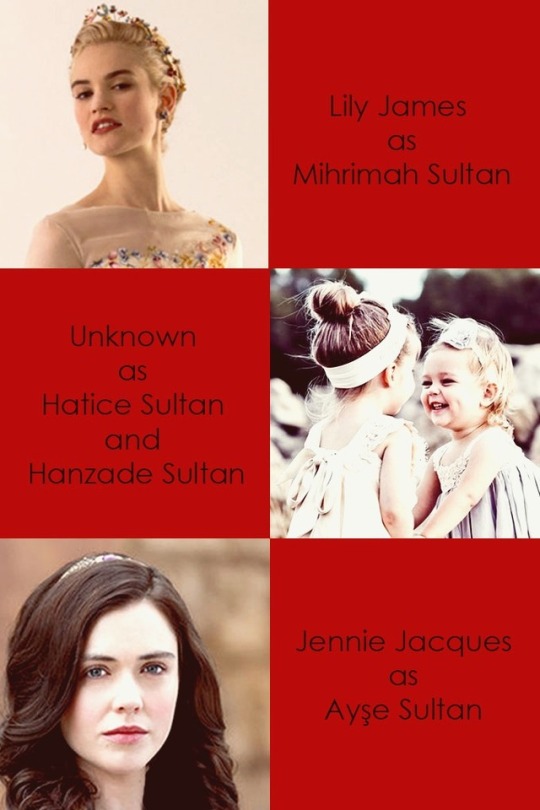
Muhteşem Yüzyıl (Magnificent Century) fancast: Daughters of Hürrem Haseki Sultan. Second generation.
1. Hümaşah Sultan (1540-1593) - daughter of Şehzade Mehmed of the Ottoman Empire.Like her cousin Ayşe Hümaşah Sultan, she was reportedly beloved by their grandfather, to whom she wrote letters.She is regarded amongst the most influential women of Suleiman's reign.This affection can be explained, in large measure, by the fact that her late father, Mehmed, was Suleiman's favorite son. It was she who, in 1563, gifted her cousin Şehzade Murad (future Sultan Murad III) with a concubine that would go on to be Safiye Sultan.
2. Ayşe Hümaşah Sultan (1541–1594) - daughter of Mihrimah Sultan of the Ottoman Empire and Rüstem Pasha. She was her parents' first child and only daughter, and possibly her grandparents' first grandchild as well. She had several brothers, whose number and names are though contested.
3. Ismihan Sultan (1544 – 1585) - daughter of Selim II and Nurbanu Sultan. She was the most powerful daughter of Selim II because she was married to the Grand Vizier Sokollu Mehmed Pasha. She is famous for having built the Sokollu Mehmed Pasha Mosque and Esmahan Sultan Mosque.
4. Gevherhan Sultan (1544 - after 1604) - daughter of Sultan Selim II and Nurbanu Sultan. Soon after his succession, Mehmed's son by Handan Sultan, Ahmed I wanted to express his gratitude to Mehmed Pasha and Gevherhan Sultan for the role they had played in bringing his parents together. He also named one of his daughters after her.
5. Şah Sultan (1545 – 1580) - daughter of Selim II and Nurbanu Sultan. The union of Şah Sultan to Zal Mahmud is said to be a very happy one. They were suited to each another. It was said that, that they fell ill at the same time, lay in their deathbeds together, and expired at the same very moment.
6. Fatma Sultan (1559–1580) - daughter of Sultan Selim II. Fatma was born in 1559,during Selim's princedom, at Konya or Karaman where he served as sanjakbey, or provincial governor, at the time.
7. Mihrimah Sultan (1547 – 1594) - daughter of Şehzade Bayezid. Married in 1562 to Damat Müzaffer Pasha.
8. Hatice Sultan and Hanzade Sultan (1550/1556-?) - daughters of Şehzade Bayezid.
9. Ayşe Sultan (1553- 1572) - daughter of Şehzade Bayezid. Married in 1562 to Damat Hoca Ali Pasha Eretnaoğlu.
#hurrem sultan#magnificent century#muhteşem yüzyıl#Mihrimah Sultan#nurbanu sultan#sultan suleyman#perioddramaedit
35 notes
·
View notes
Note
Hi 🌸 I wanna know more about Beyazid II like his life as a prince and as a sultan, his wives and children (besides Selim I of course)
Thank you for your question. We want to give you an answer that is as accurate as possible, so we double-check all our sources, and due to how comprehensive this answer is going to be, we decided to split it up. I will start with his wives and Joanna, Lina and Veronica will work on the rest, so we kindly ask you to come back in a couple of days for that.
Gülbahar Hatun
Her name and her identity as a whole is disputed—it’s difficult to determine whether Gülbahar and Ayşe were two different wives or not. The oldest source on this, as well as Babinger and Alderson, identify Ayşe as Selim I’s mother, however, according to Sicill-i Osmanî, her name is Gülbahar.
Gökbilgin and Danişmend support the theory that Ayse, daughter of the Bey of Dulkadir, was Bayezid’s lawfully wedded wife and Selim’s mother, and Gökbilgin claims that Ayşe might have been Gülbahar. Sakaoğlu, however, states that there is no further information on Ayşe and proposes that one source of confusion could be that Bayezid’s own mother was also called Gülbahar. He writes that there is no doubt that Ayşe was lawfully wedded to Bayezid, but that there is no indication of her being Selim’s mother, and he notes that it is curious that, when Selim had Ayşe’s father—and therefor, if she was indeed his mother, his grandfather—executed, chroniclers did not mention this fact.
Therefor she might have been Maria, the daughter of a Pontic Greek priest, or Ayşe, the daughter of Alaüddevle Bozkurt Bey
In keeping with the former, she supposedly was captured during the conquest of Trabzon and given to Bayezid
She gave birth to Selim I when Bayezid was still a şehzade and later accompanied Selim to Trabzon and Samandıra
Selim had the Hatuniye Külliyesi built in her name
She died before her son ascended the throne, and is buried in the Gülbahar Hatun Camii in Trabzon that was built in honor of her
According to Halil Edhem Eldem, archaeologist, the inscription of her tomb reads: “May Bânû-yı Rûm, who has turned her face from the world towards eternity, sit on the throne of Heaven and may God bless her”
Nigar Hatun
Her vakfiye reads “daughter of Abdullah”, this indicates that she was a slave concubine who converted to Islam upon entering the harem
She gave birth to Fatma Hatun, Ayse Hatun and Şehzade Korkut when Bayezid himself was still a şehzade
When Mehmed II died and Bayezid ascended the throne, she accompanied him to Constantinople
As expected of her, she went with Korkut when he was sent to Manisa and Antalya to govern
After Selim I had his brother executed, she returned to Antalya
Hüsnüşah Hatun
Some sources identify her as the mother of one Nasuh Bey, however, Sakaoğlu says that this is incorrect since she’s referred to as Hüsnüşah, daughter of Abdullah (see above)
She was the mother of Şehzade Şehinşah and Sultanzade Hatun
She corresponded with Selim I on behalf of Mevlana Pir Ahmed Çelebi, a scholar who had been at her sons court, and who was neglected when the members of the prince’s household were assigned new posts
She had the Hatuniye Mosque Complex built in Manisa, one of the “most beautiful” ones
Şirin Hatun
Her vakifye also describes her as “daughter of Abdullah”, so she too would have been a converted slave concubine
She gave birth to Bayezid’s first son, Şehzade Abdullah, when he was still a şehzade, and was the mother of Aynışah Hatun
Şirin accompanied Abdullah when he was sent to govern Manisa and Karaman
After her son’s death, she went to Bursa and later had a tomb built for him, where she would be buried
Sakaoğlu states she also had a mosque built in Trabzon
Gülruh Hatun
Mother of Şehzade Alemşah and Kamerşah Hatun
Alemşah was sent to govern Manisa, and Gülruh accompanied him
She put much effort into protecting her son, whose conduct Bayezid seems to have found unsatisfactory, as he ordered her to discipline him
In a letter to Bayezid she states “I have done everything I can to preserve order“ and Peirce writes “[she] goes on to present her case against seven members of her son’s suite—including his tutor (lala), his doctor, and his preceptor—to whom she attributes responsibility for the problems“ and expresses concerns about her son’s health
I will include an excerpt of her letter below:
My fortune-favored padishah, heed my cry for help,… rid us of [my son’s] tutor, teacher, and doctor. They are masters of corruption…. Send us good Muslims, because our situation has been pitiful since these persons arrived. They have deprived me of my mother’s rights…. If these seven do not go, they will utterly destroy the household of my son, your servant.
According to Uluçay, she had a mosque and a soup kitchen built in Akhisar, Aydın Güzelhisar and Duraklı
She died in the early days of Süleyman’s reign
Bülbül Hatun
Mother of Şehzade Ahmed and Hundi Hatun
Bayezid favored their son Ahmed as his successor, who was Selim’s principal rival
Sakaoğlu describes her as “benevolent”; she had built and endowed a religious college in Bursa, and a mosque and a soup kitchen in Ladik
In Amasya, she had another mosque, a school and a fountain built
She also had a tomb built for Ahmed, in which she was buried at her death
Ferruhşad/Ferahşad Hatun
Mother of Şehzade Mehmed
According to Sakaoğlu, Bursa’s registry refers to her as Muhterem Hatun; he suggests that she might have carried the double name Muhterem Ferruhşad
After her son’s death, she retired to Bursa
She established a foundation in Silivri in 1521
Mühümaz Hatun
Alderson names her as the mother of Şehzade Korkut and states that Fisher says he was the full-brother of Selim, and therefor son of Ayşe/Gülbahar
However, Uluçay corrected Şehzade Korkut’s mother as Nigar Hatun (see above), likewise Sicill-i Osmanî does not mention a Mühürnaz/Mihrinaz among Bayezid’s wives
Therefor her existence/identity is disputed
Unnamed Hatun
Uluçay does not list her at all; Sakaoğlu refers to H. Hüsameddin, who writes that Bayezid’s first wife was the oldest daughter of Emir Bey
Alderson lists her as the mother of Şehzade Mahmud and Gevheri Muluk

Sources:
Alderson, Anthony Dolphin: The Structure of the Ottoman Dynasty, Greenwood Press, 1982
Binous, Jamila: Early Ottoman Art: The Legacy of the Emirates, Museum With No Frontiers, 2002
Peirce, Leslie: The Imperial Harem. Women and Sovereignty in the Ottoman Empire, Oxford University Press, 2010
Sakaoğlu, Necdet: Famous Ottoman Women, Avea, 2007
Sakaoğlu, Necdet: Bu Mülkün Kadın Sultanları. Valide Sultanlar, Hatunlar, Hasekiler, Kadınefendiler, Sultanefendiler, Basım Yayım Dağıtım San. ve T ic. Ltd. Şti, 2015
Uluçay, Mustafa Çağatay: Padişahların kadınları ve kızları, Ankara, Ötüken. 2011
26 notes
·
View notes
Text

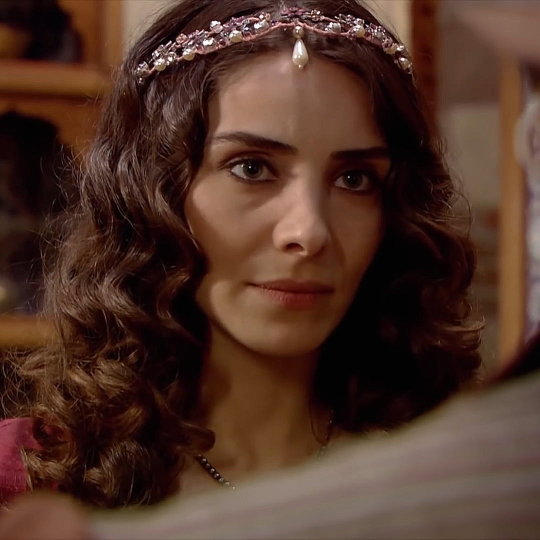





This pink tiara with a pearl drop was first worn by Hatice Sultan in the fourth episode of the first season of Magnificent Century. It was worn again by Mahidevran Sultan in the nineteenth episode of the same season. Gülfem Hatun can also be seen with it in the tenth episode of the second season. The tiara appears again on Mihrimah Sultan in tenth episode of the third season. During the use on her, the pearl drop eventually gets removed. The fourth season saw the tiara three times, first on Nurbanu Sultan in the tenth episode, then on Nergisşah Sultan in the eighteenth episode and lastly on Ayşe Sultan in the twenty-ninth episode.
#Muhteşem Yüzyıl#Magnificent Century#period drama#costume drama#historical drama#Hatice Sultan#Hatice Sultan (Daughter of Hafsa)#Mahidevran Sultan#Gülfem Hatun#Gulfem Hatun#Mihrimah Sultan#Mihrimah Sultan (Daughter of Hürrem)#Nurbanu Sultan#Nergisşah Sultan#Nergissah Sultan#Ayşe Sultan#Ayse Sultan#Ayşe Sultan (Daughter of Şehzade Bayezid)#reused jewellery#recycled jewellery
28 notes
·
View notes
Text


This white fur cape was first worn by Hümaşah Sultan in the eighteenth episode of the fourth season of Magnificent Century. It was worn again by Ayşe Sultan sixteen episodes later.
#Muhteşem Yüzyıl#Magnificent Century#period drama#costume drama#historical drama#Hümaşah Sultan#Humasah Sultan#Ayşe Hümaşah Sultan#Ayse Humasah Sultan#Hümaşah Sultan (Daughter of Mihrimah)#Ayşe Hümaşah Sultan (Daughter of Mihrimah)#Ayşe Sultan#Ayse Sultan#Ayşe Sultan (Daughter of Şehzade Bayezid)#reused costumes#recycled costumes
15 notes
·
View notes
Text





In the twenty-fifth episode of the fourth season of Magnificent Century, Şehzade Selim's and Nurbanu Sultan's triplets Gevherhan, İsmihan and Şah Sultan wear three nearly identical pink and golden kaftans. However, they can be differentiate by looking at the center front pattern which begins its pattern in different positions at the neckline.
The kaftan worn by Gevherhan Sultan (left), is also worn by her cousin Şehzade Bayezid's daughter Ayşe Sultan in the twenty-ninth episode of the same season.
The kaftan worn by İsmihan Sultan (middle) appears again in the second season of Magnificent Century: Kösem. It can be seen on Hanzade Sultan in the second episode and on Turhan's daughter Beyhan Sultan in the twenty-ninth episode.
The kaftan worn by Şah Sultan (left) also appears on the second season of Magnificent Century: Kösem, where it is worn by Kaya Sultan in the twenty-sixth episode.
#Magnificent Century#Magnificent Century Kösem#Magnificent Century Kosem#Muhteşem Yüzyıl#Muhteşem Yüzyıl: Kösem#period drama#costume drama#historical drama#Şah Sultan#Sah Sultan#Şah Sultan (Daughter of Nurbanu)#İsmihan Sultan#Ismihan Sultan#Gevherhan Sultan#Gevherhan Sultan (Daughter of Nurbanu)#Ayşe Sultan#Ayse Sultan#Ayşe Sultan (Daughter of Şehzade Bayezid)#Hanzade Sultan#Kaya Sultan#Beyhan Sultan#Beyhan Sultan (Daughter of Turhan)#recycled costumes#reused costumes
20 notes
·
View notes
Text



This pinkish brown coat with a light brown fur collar was first worn by Huricihan Sultan in the twenty-sixth episode of the second season of Magnificent Century. Buttons and further embroidery were added to the coat, before it was worn again by Ayşe Sultan in the thirty-first episode of the fourth season.
The coat is briefly seen again on Bican Sultan in the twenty-seventh episode of the second season of Magnificent Century: Kösem.
#Muhteşem Yüzyıl#Muhteşem Yüzyıl: Kösem#Magnificent Century#Magnificent Century Kösem#Magnificent Century Kosem#period drama#costume drama#historical drama#Huricihan Sultan#Ayşe Sultan#Ayse Sultan#Ayşe Sultan (Daughter of Şehzade Bayezid)#Bican Sultan#reused costumes#recycled costumes
13 notes
·
View notes
Text
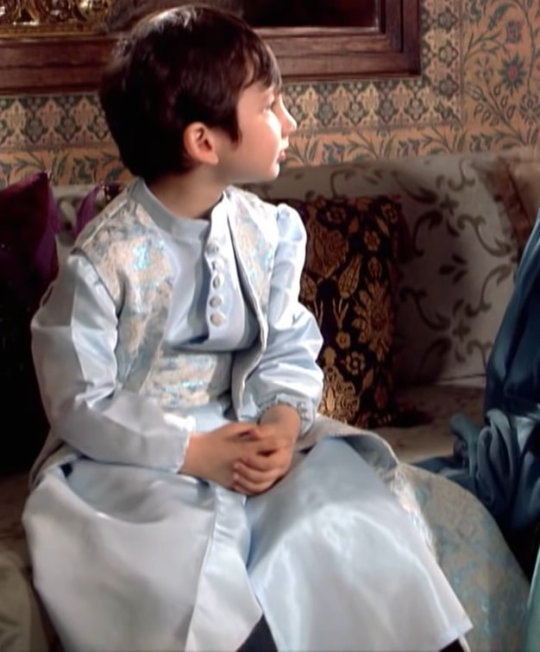





This blue and silver kaftan was first worn by Şehzade Mehmed in the seventeenth episode of the first season of Magnificent Century. It is worn again by Şehzade Bayezid in the twenty-ninth episode of the second season. The kaftan is also briefly seen on an unnamed guest in the thirty-sixth episode of the third season. The fourth season used it twice, first on Şehzade Orhan in the fifth episode and then on Ayşe Sultan in the thirty-first episode.
The kaftan also appeared on Şehzade Süleyman in the twenty-second episode of the second season of Magnificent Century: Kösem.
#Muhteşem Yüzyıl#Muhteşem Yüzyıl: Kösem#Magnificent Century#Magnificent Century Kösem#Magnificent Century Kosem#period drama#costume drama#historical drama#Şehzade Mehmed#Sehzade Mehmed#Şehzade Mehmed (Son of Hürrem)#Şehzade Bayezid#Sehzade Bayezid#Şehzade Bayezid (Son of Hürrem)#Unnamed Istanbul Citizens#Şehzade Orhan#Sehzade Orhan#Şehzade Orhan (Son of Şehzade Bayezid)#Ayşe Sultan#Ayşe Sultan (Daughter of Şehzade Bayezid)#Ayse Sultan#Şehzade Süleyman (Son of Farya)#Şehzade Süleyman#Sehzade Suleyman#reused costumes#recycled costumes
14 notes
·
View notes
Text


This striped purple kaftan was first worn by Mihrimah Sultan in the first season of Magnificent Century.
It was worn again by Şehzade Bayezid's daughter Ayşe Sultan in the twenty-seventh episode of the fourth season.
#Magnificent Century#Muhteşem Yüzyıl#period drama#costume drama#historical drama#Mihrimah Sultan#Mihrimah Sultan (Daughter of Hürrem)#Ayşe Sultan#Ayse Sultan#Ayşe Sultan (Daughter of Şehzade Bayezid)#recycled costumes#reused costumes
13 notes
·
View notes
Text



This blue night gown was first worn by Sultanzade Osman in the twenty-first episode of the second season of Magnificent Century. It is worn again by Şehzade Cihangir in the twenty-ninth episode of the same season. The dress makes another appearance on Şehzade Bayezid's daughter Ayşe Sultan in the twenty-seventh episode of the fourth season.
#Muhteşem Yüzyıl#Magnificent Century#period drama#costume drama#historical drama#Sultanzade Osman#Sultanzade Osman (Son of Hatice)#Şehzade Cihangir#Sehzade Cihangir#Ayşe Sultan#Ayse Sultan#Ayşe Sultan (Daughter of Şehzade Bayezid)#reused costumes#recycled costumes
11 notes
·
View notes
Text








This red and golden kaftan was first worn by Sultanzade Osman in the twenty-second episode of the third season of Magnificent Century. It is worn again ten episodes later by Osman's twin sister Huricihan Sultan. The kaftan also appears on Şehzade Cihangir in the thirty-ninth episode of the same season. The fourth season used the kaftan twice, first on Şehzade Mustafa in the twentieth episode and the on Ayşe Sultan in the thirty-fourth episode.
Magnificent Century: Kösem saw the kaftan again on Şehzade Murad (later Sultan Murad IV) in the twenty-first episode of the first season. It was worn again by him with added fur in a flashback in the twenty-sixth episode of the second season.
The kaftan can also be briefly seen on an unnamed Enderûn student in the first episode of the first season of Golden Apple: The Grand Conquest.
#Muhteşem Yüzyıl#Muhteşem Yüzyıl: Kösem#Magnificent Century#Magnificent Century Kösem#Magnificent Century Kosem#Kızılelma: Bir Fetih Öyküsü#Golden Apple: The Grand Conquest#period drama#costume drama#historical drama#Sultanzade Osman#Sultanzade Osman (Son of Hatice)#Huricihan Sultan#Şehzade Cihangir#Sehzade Cihangir#Şehzade Mustafa#Sehzade Mustafa#Şehzade Mustafa (Son of Mahidevran)#Ayşe Sultan#Ayse Sultan#Ayşe Sultan (Daughter of Şehzade Bayezid)#Şehzade Murad#Sehzade Murad#Murad IV#Şehzade Murad (Son of Kösem)#Unnamed Enderûn Students#reused costumes#recycled costumes
6 notes
·
View notes
Text



This red and golden kaftan was first worn by Ayşe Sultan in the thirty-second episode of the fourth season of Magnificent Century.
It is seen again on Şehzade Mustafa (later Sultan Mustafa I) in the ninth episode of the first season of Magnificent Century: Kösem. The kaftan was also worn by Şehzade Süleyman (later Sultan Süleyman II) in the twenty-seventh episode of the second season.
#Muhteşem Yüzyıl#Muhteşem Yüzyıl: Kösem#Magnificent Century#Magnificent Century Kösem#Magnificent Century Kosem#period drama#costume drama#historical drama#Ayşe Sultan#Ayse Sultan#Ayşe Sultan (Daughter of Şehzade Bayezid)#Şehzade Mustafa#Sehzade Mustafa#Mustafa I#Şehzade Mustafa (Son of Halime)#Şehzade Süleyman#Sehzade Suleyman#Süleyman II#Şehzade Süleyman (Son of Dilaşub)#reused costumes#recycled costumes
9 notes
·
View notes
Text



This light pink dress with pink and golden accent trimming is first worn by Esmanur Hatun in the twelth episode of the third season of Magnificent Century. It is seen again on Nergisşah Sultan in the thirty-first episode of the same season. The dress is also worn by Şehzade Bayezid's daughter Ayşe Sultan in the thirtieth episode of the fourth season.
#Magnificent Century#Muhteşem Yüzyıl#period drama#costume drama#historical drama#Esmanur Hatun#Nergisşah Sultan#Nergissah Sultan#Ayşe Sultan#Ayse Sultan#Ayşe Sultan (Daughter of Şehzade Bayezid)#recycled costumes#reused costumes
10 notes
·
View notes